

Ikeshima: A Semi-Abandoned Island
Ikeshima is the fallback island for explorers disappointed not to have visited Gunkanjima. But despite the shadow of its neighbour, this is a great island!
The island of Ikeshima (or Ikejima) lies west of the Nishiheiki peninsula in Nagasaki prefecture. At its peak in the 1970s, this small island of less than a square kilometre had a population of almost 8,000.
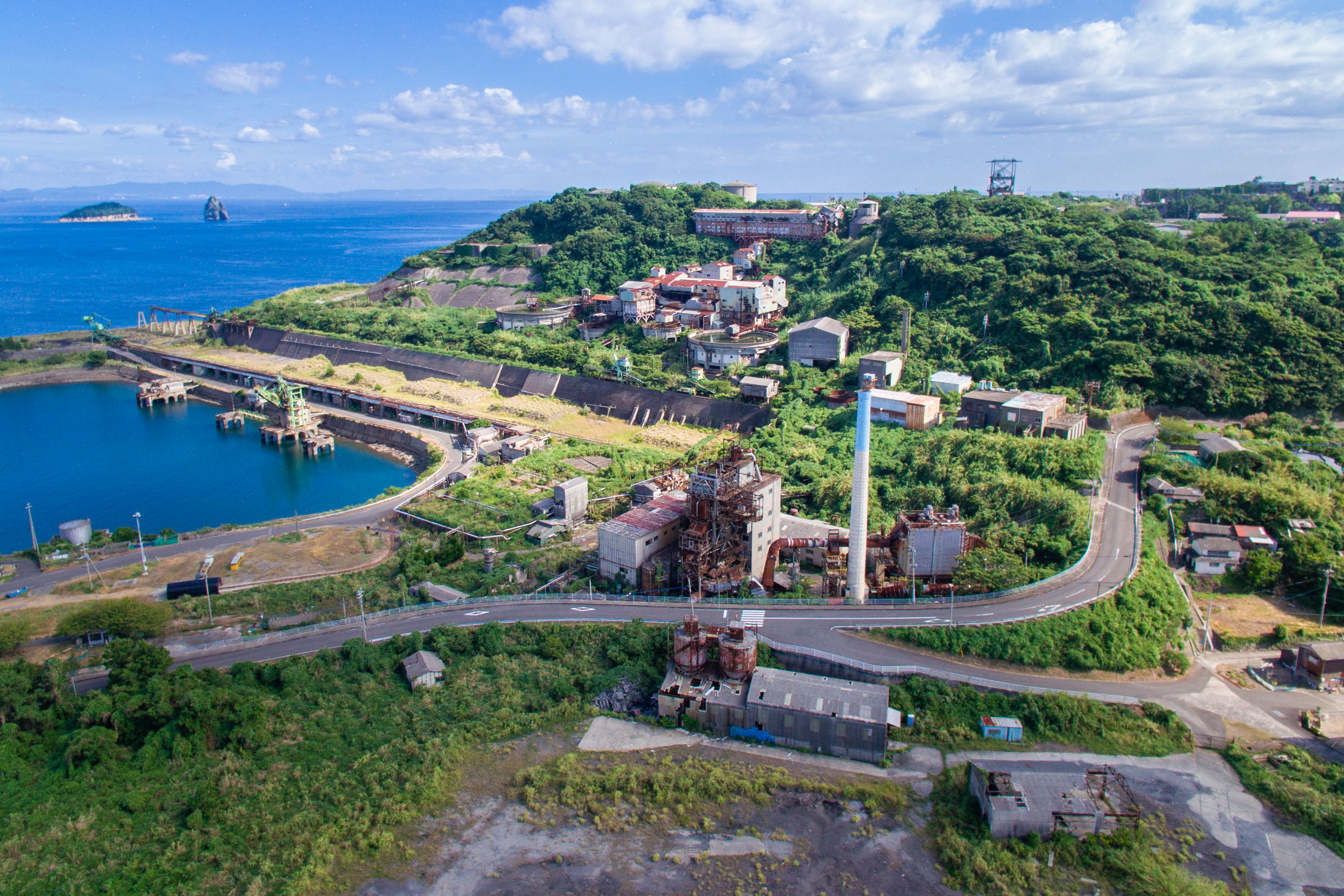
The reason for this density in such a remote and restricted area was the coal mine. Before its construction, Ikeshima was simply an agricultural and fishing island.
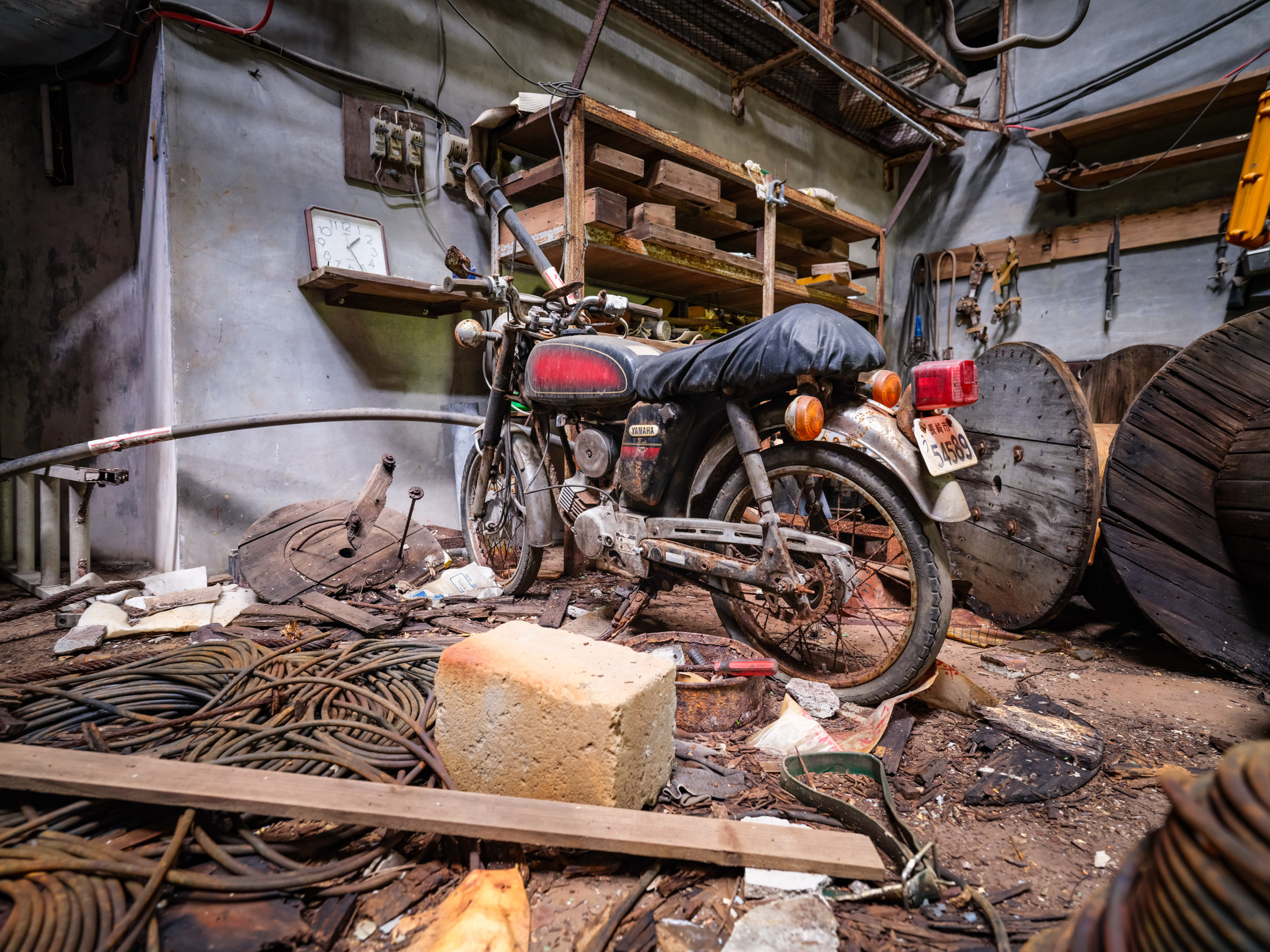
Abandoned mine
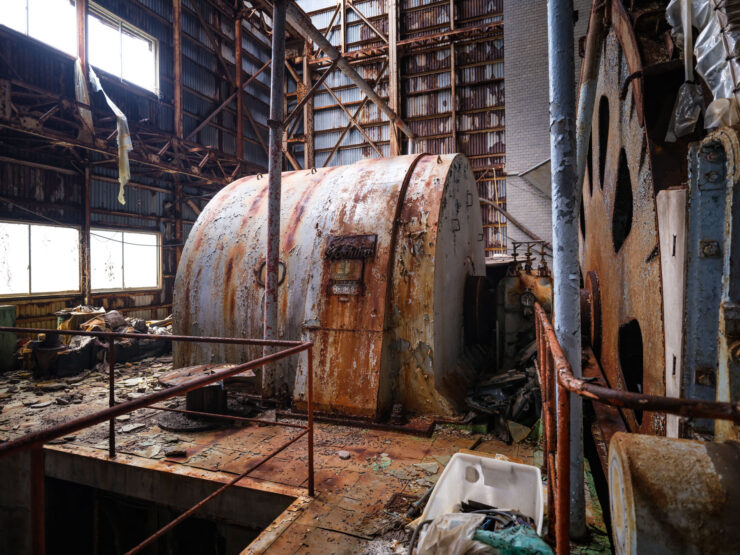
Forgotten offices
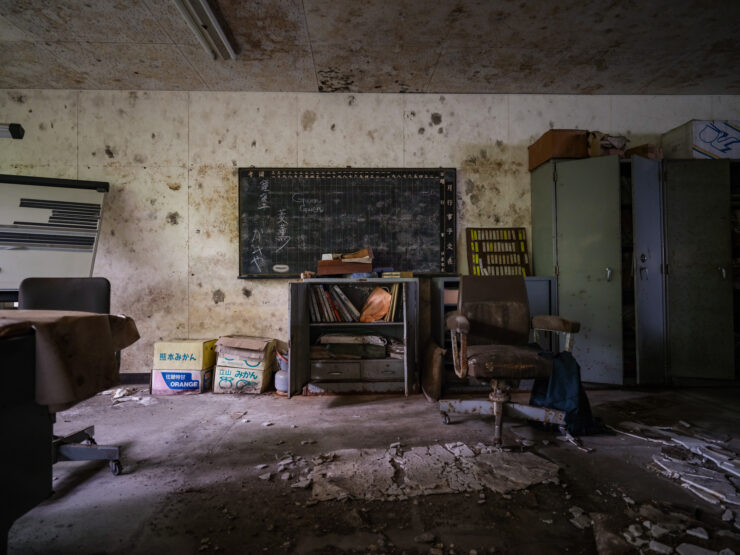
There was originally a large pond on the island, Kagamigaike (Mirror Pond), linked to the legend of Empress Kamiko who would have seen her reflection in it. The island has been called “Ikeshima” or “Pond Island” in reference to this event. However, the development of coal mining later led to the destruction of the pond to build a port.
Night on Ikeshima
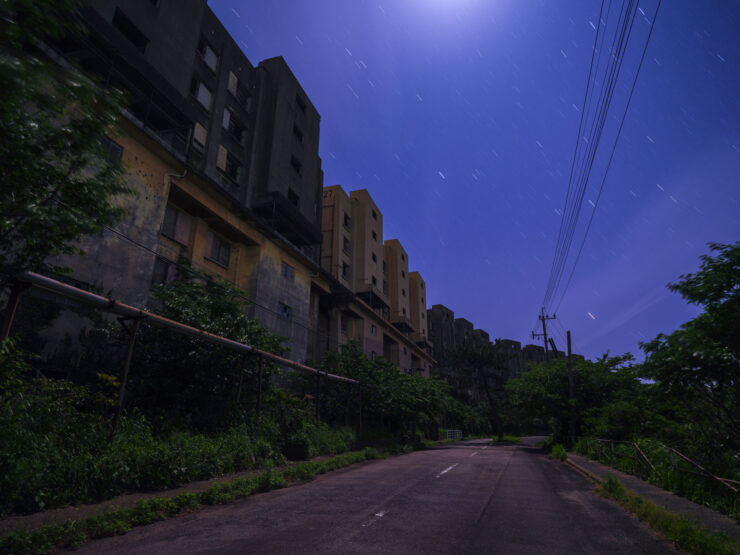
Not long after the war, in 1952, the Matsushima Group acquired the coal-rich lands for the development of an underwater mine. Mining operations began in 1959 when the industry was declining in the face of the energy revolution. Ikeshima was able to expand rapidly to reverse this trend.
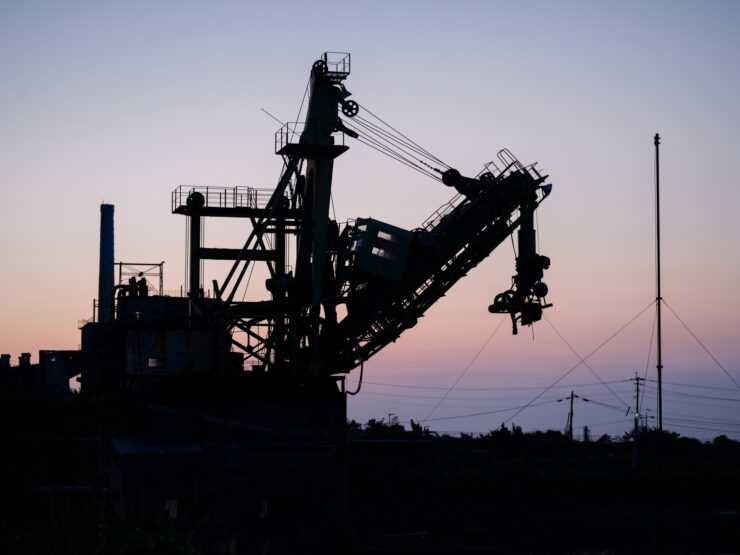
Ikeshima from the sky!
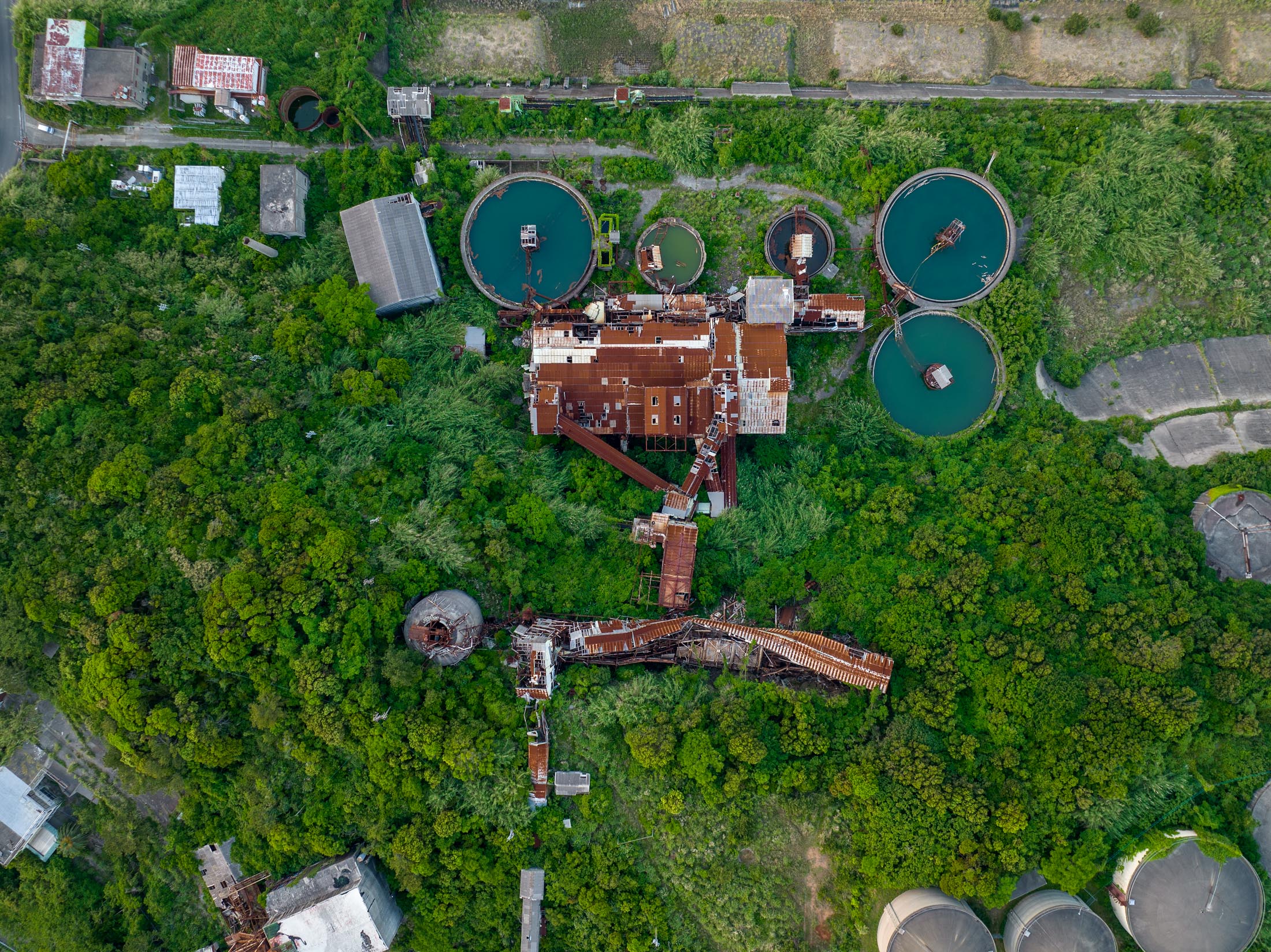
By the 1990s the surface area of the mine had reached 35,000 hectares, with a total tunnel length of over 90 kilometres. To facilitate the movement of workers, the company developed fast tracks with a three-wagon train that could carry up to 27 passengers.
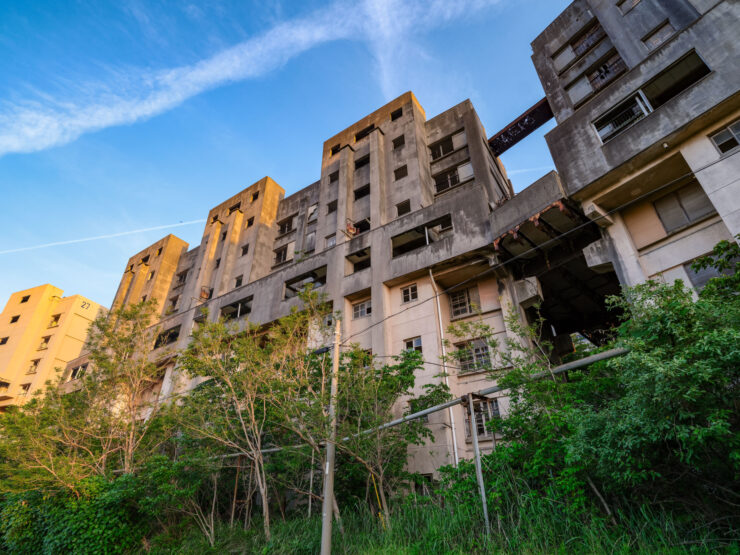
Cats, the new residents
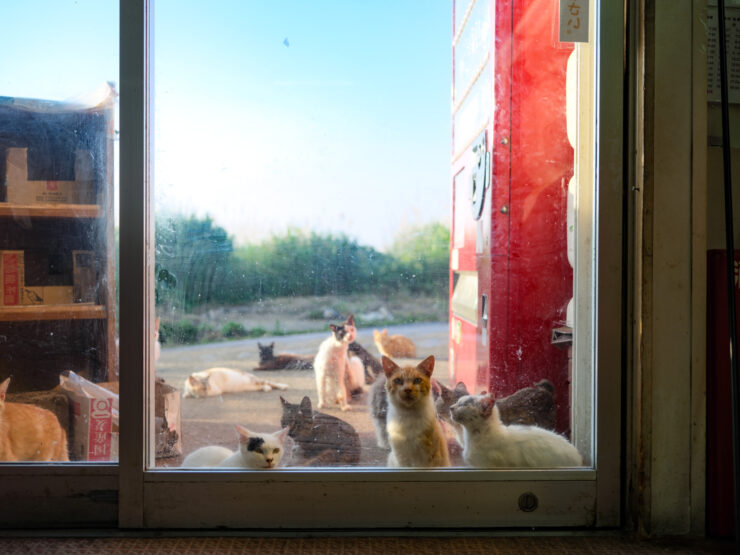
In the production peak of the 1980s, more than 1.5 million tonnes of coal were extracted.
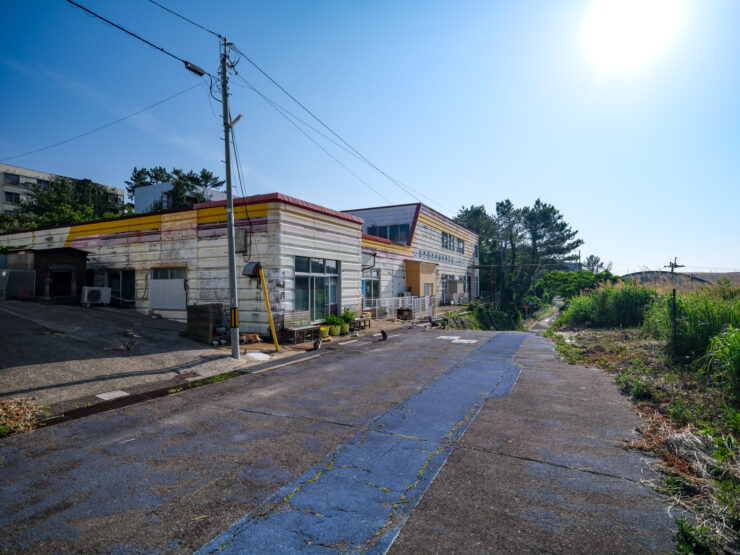
Between 1950 and 1970, the population grew from 350 to more than 7,500. As on the nearby island of Hashima (Gukanjima), hospitals, schools, housing blocks were built from reinforced concrete. The daily rent for these apartments was just 400 yen, and included communal facilities such as a laundry room and onsen (baths).
A walk through town
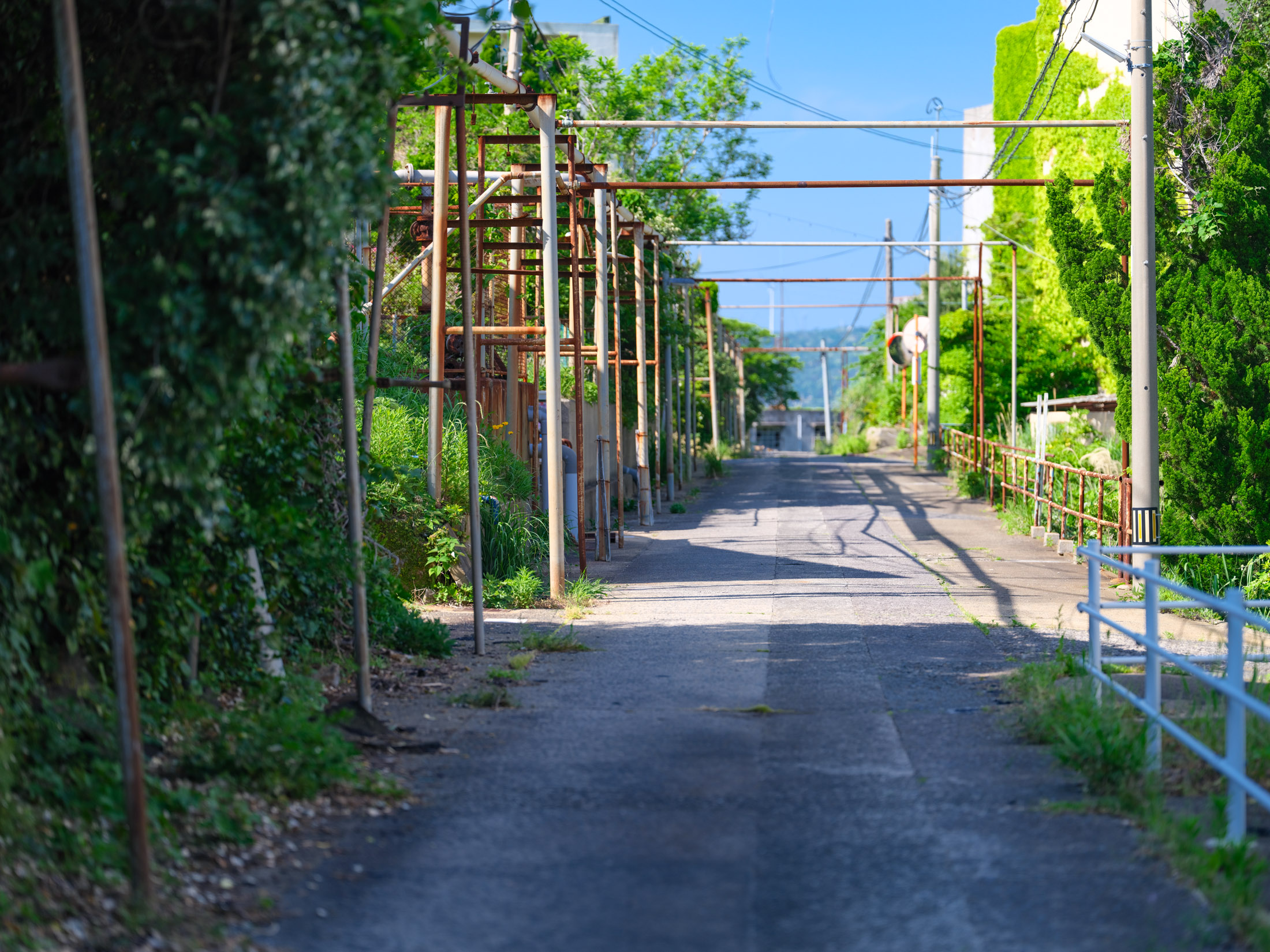
In the late 1990s, following a series of accidents and stiff competition from imported coal, Ikeshima’s mining activities slowed down. Despite government aid, the mine finally closed in 2001. The 2,500 employees who were still working there were all made redundant and left the island.
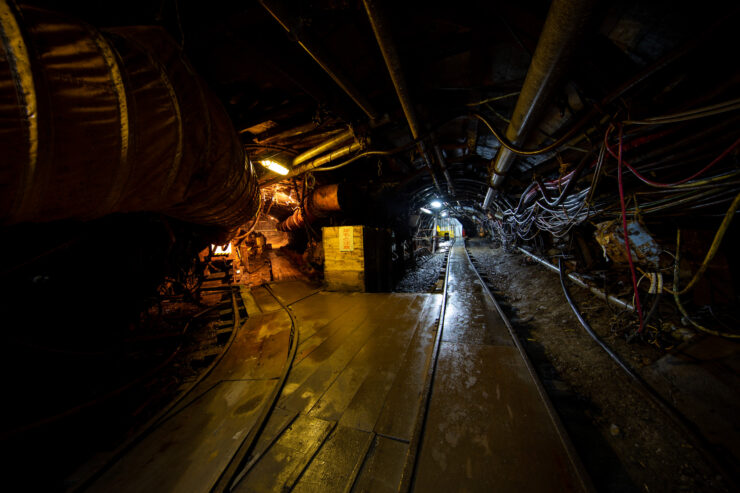
Eighteen years after its closure, most of the facilities remain and parts of the site seem to be used as a training centre for coal mining engineers from Vietnam and Indonesia. It’s still hard to say exactly what’s abandoned or what isn’t, even if everything seems to be in very poor shape!
Ikeshima’s abandoned clinic
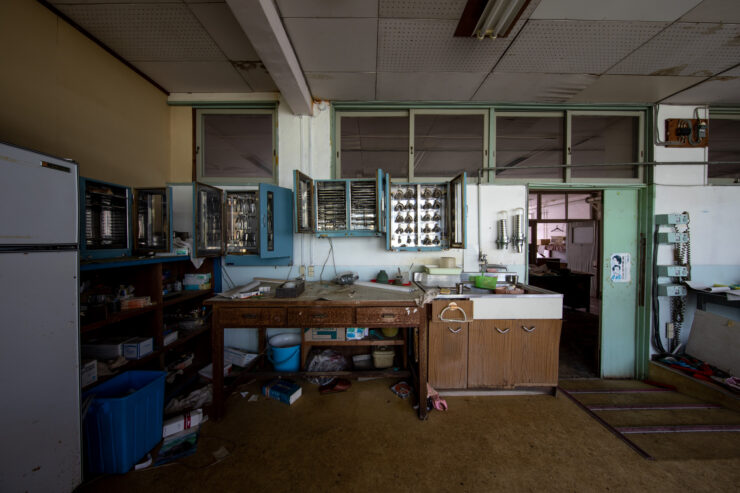
Today there are only around a hundred residents left, most of them retired miners who keep the memory of the place alive … much to the tourists’ delight!
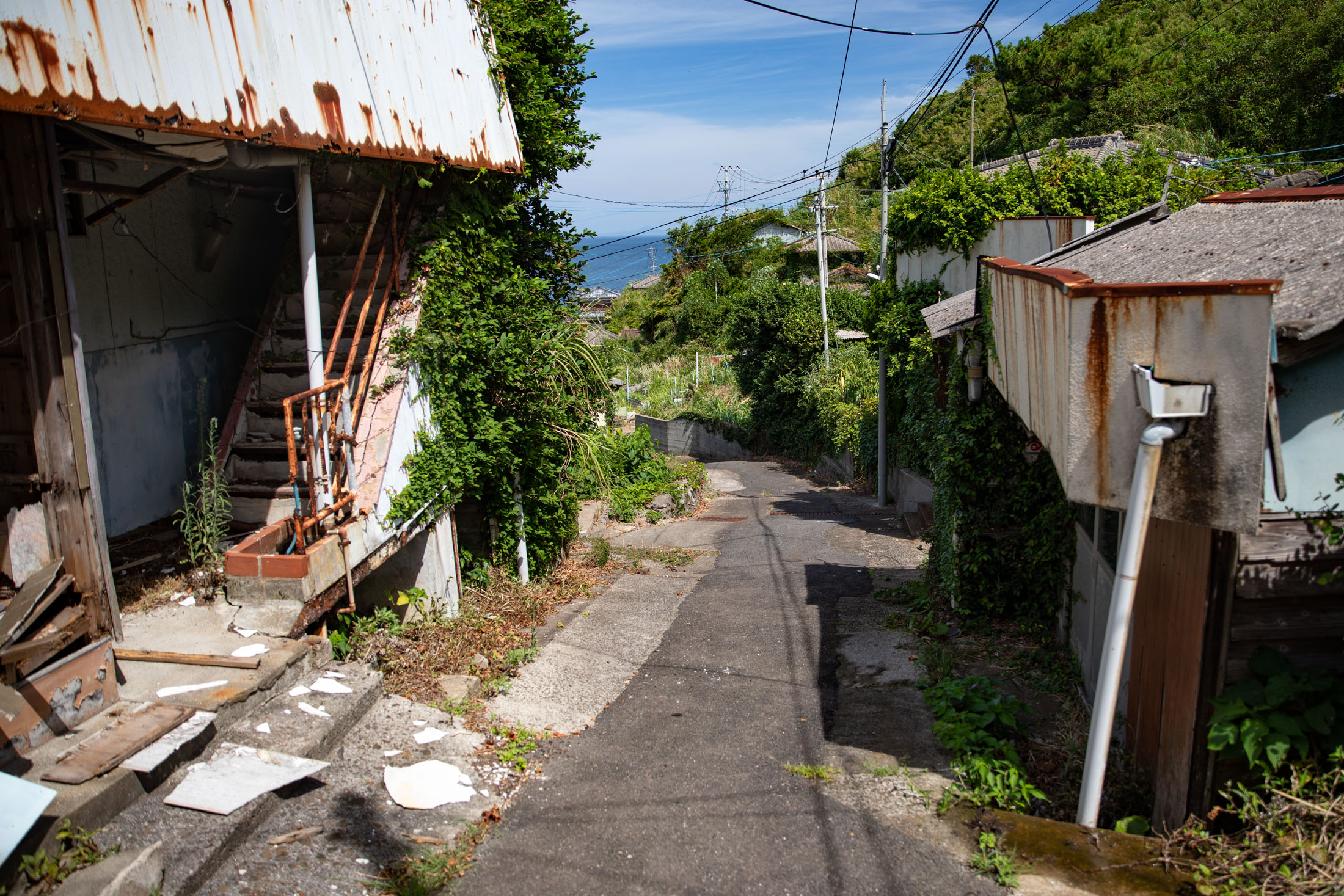
And for more awesome content about Japan, follow Jordy Meow on Instagram ! 🎵
À lire aussi...
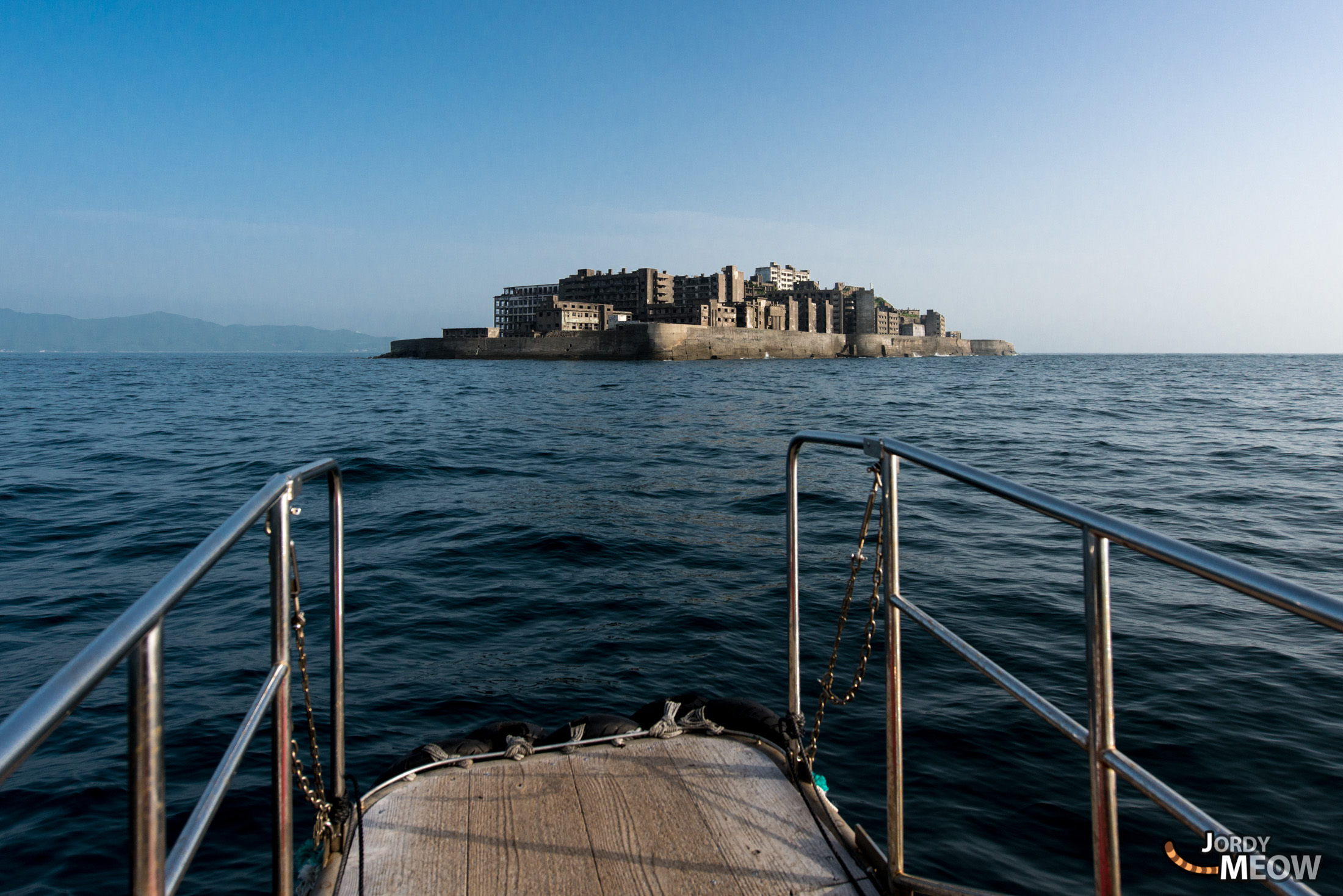
Gunkanjima: Photos & Stories
Abandoned in 1974, the Battleship Island (Gunkanjima) turned into the Ghost Island and soon became one of the most famous spot for urban exploration.
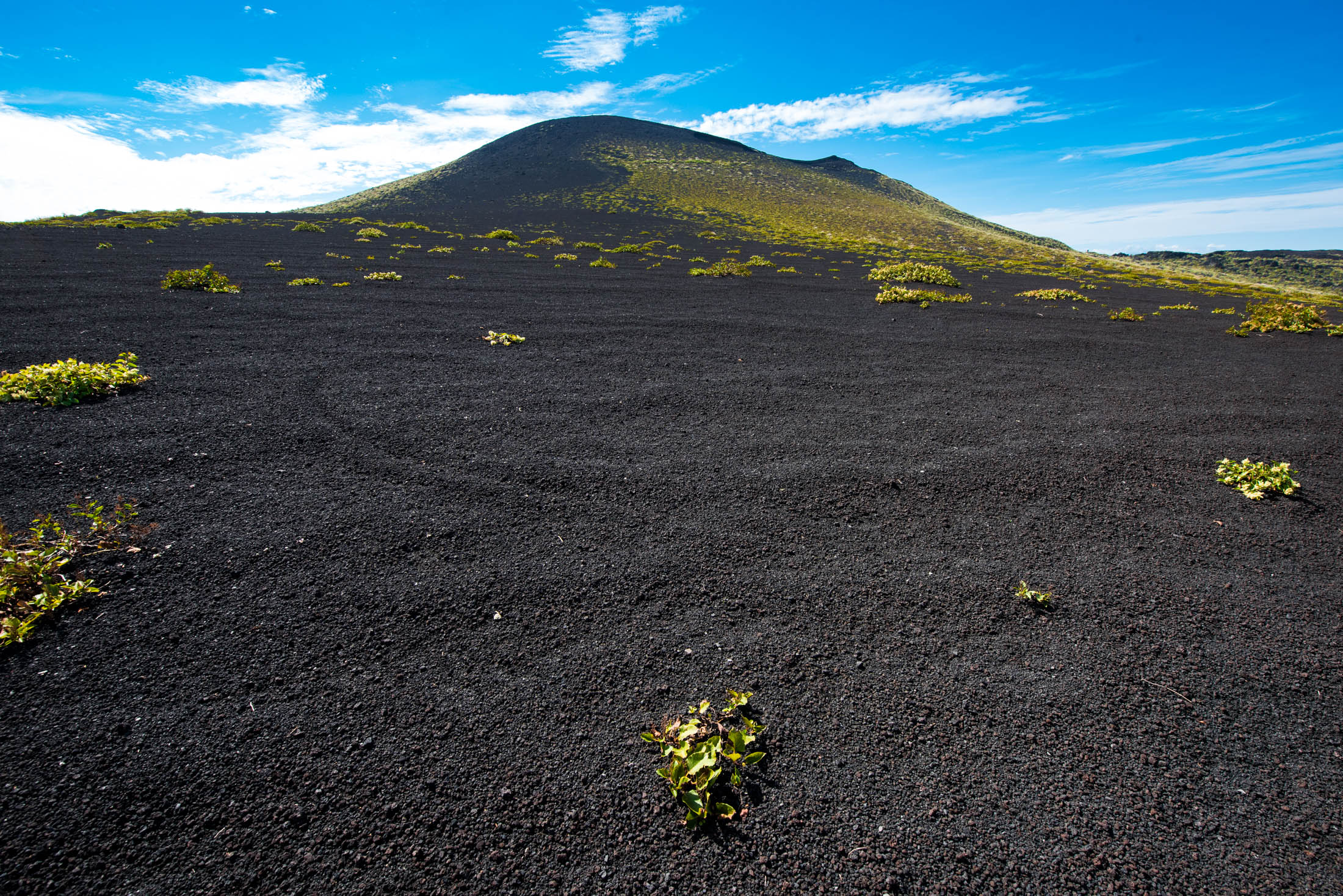
Oshima and its Black Desert
Oshima is the largest island in the Izu peninsula. It has an active volcano surrounded by black desert... the only desert in Japan!

I am Jordy Meow, a French photographer based in Tokyo . I explore offbeat places in Japan.

- The Sakura of Komatsunagi: Petals and Legends

- Rishiri Island

- Abandoned Akeno Strip Club

- Kanazawa Spring and Winter

- Magome for All Tastes

The Funaya of Ine

Nostalgia for Canada at Hokkaido

Takayama Inari Shrine

The Incredible Kamishikimi Kumanoimasu Shrine

The Floral Paradise of Ashikaga

2,771 58,928
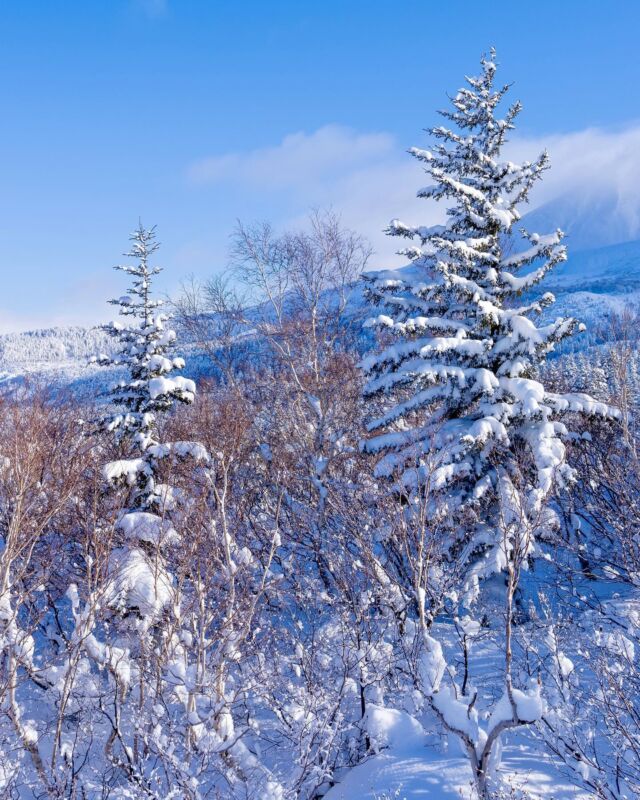
Other Works
- Jipangu: Blogs & Vlogs du Japon
- Kotoba: Le Dictionnaire Japonais / Français
- Blog: Une Année en Chine
- Ikuzo: The Map Editor for Photographers & Travelers
- Meow Apps: The Best WordPress Plugins for Photographers
- Export Google Maps
Created by Jordy Meow . Copyright © 2024.

Aogashima: Double Volcano Island

The Snow Monsters of Mount Zao

Futuro House in Japan

The Abandoned Wakagawa Power Plant

Arashiyama Bamboo Grove

Natadera Temple

Osaka Great Peace Tower

Nippara: Where The Samurai Came To Find Peace

Gunkanjima: The Memories of Doutoku Sakamoto

Gunkanjima: The Block 65

Gunkanjima: A Full-Moon Night

Gunkanjima: Between Hell & Paradise

Hachijo Royal Hotel: The Largest Abandoned Resort in Japan

Pyongyang Inside Out

Pyongyang, North Korea

North Korea by train, Kaesong and the DMZ
Recent posts.
- How it works
- Fees & Service
- Shipping & Customs
- Prohibited goods
- Free registration
- Terms & Conditions
- Japan Fan Club Proxy Service
- Japan Real Estate Purchase Support
- Event organization in Japan
- Event organization outside of Japan
- Support to get Japanese Translation of foreign driver’s license
- Japan Tour Guide Support/Tour guide list
- Japan Drink and Food Subscription Service
- Japan Travel Booking/Reservation Support
- Hotel tester
- Marketing Service BPO
- Japan China Exhibition Support
- Promotion Service
- Anti-Harassment seminar / Training in Japan
- OK Agent Support
- Market Entry Support/Promotion Service/Translation
- Translation/localization service
- How To Get a Job in Japan?
- Web/app development
- OK Investment for Startups
- Kimono/T shirts Production Service
- Kimono Rental
- Kimono Cleaning
- How to Wash Kimono at Home?
- Japan Media Support/Local Fixer
- Wie es funktioniert
- Gebühren & Service
- Lieferung & Zoll
- Unerlaubte Gegenstände
- Häufige Fragen
- Kostenlose Registrierung / Kontakt
- Japan Fan Club Service
- Japan Reise Support
- Führerschein Übersetzungs Support für Japan
- Markteintritts- unterstützung
- Übersetzung
- Konditionen
- 海外模造品・コピー品対策サービス
- アプリ・ウェブサービスの開発
- 多言語ウェブサイト作成・ソフトウェアローカライゼイション
- 越境EC構築・運営(オンラインでの海外販売)
- 海外ウェブマーケティングBPOサービス
- アニメ・動画・3D・イラスト作成
- トリップアドバイザー等掲載代行
- 大衆点評等の掲載代行(中国向け)
- ご当地名物プロデュース
- ホテル、レストランなど外国人観光客対応簡単導入方法
- 外国人観光客予約受付代行
- ホテルテスターサービス
- 海外ホテル・レストラン予約サービス
- シンプル海外進出コンサルプラン
- 海外営業・販売支援・調査・広告
- 海外法人登記 -ドイツ法人登記
- 海外法人登記 -米国デラウェア州法人登記
- 海外法人登記 -パナマ法人登記
- パナマ船籍の取得サービス
- 海外法人登記 -セントクリストファー・ネイビス法人登記
- 海外法人登記 -ベトナム法人登記
- 海外法人登記 -インドネシア法人登記
- 海外法人登記 -エジプト法人登記
- 海外法人登記 -ガーナ法人登記
- 海外法人登記 -ミャンマー法人登記
- 海外法人登記 -マレーシア法人登記
- 海外法人登記-タイ法人登記
- 海外法人登記 -フィリンピン法人登記
- 海外法人登記 -ラオス法人登記
- 海外ビザ支援 - パナマ国 ビザ・移住サポート
- 海外ビザ支援 -マレーシア ビザ・移住サポート
- 海外ビザ支援 - ベトナム ビザ・移住サポート
- 海外ビザ支援 - バングラデシュ ビザ・移住サポート
- 海外イベント企画・実施・運営
- 事案 - 東南アジアホテル買収案件
- 事案 - 海外美容ビジネス進出
- 事案 - 中国展示会出展
- 事案 - 中国の店舗デザイン・施工
- 事案 - ベトナムの店舗デザイン・施工-
- 事案 - 東南アジア商業施設買収案件
- 事案 - 海外消費者リサーチ
- 事案 - アフリカ進出支援
- 国内外展示会ブース設計/設営・販促品・POP・SP企画制作
- 店舗・什器デザイン制作
- 記念品・ノベルティーグッズ企画・制作
- 留学生・外国語人材ガイドマッチングサービス
- 海外取材手配・支援・コーディネート
- Japanese Online Shops
- Travel info & News

How to Get Ikeshima Island and Where to Stay: Forgotten Coal Mine
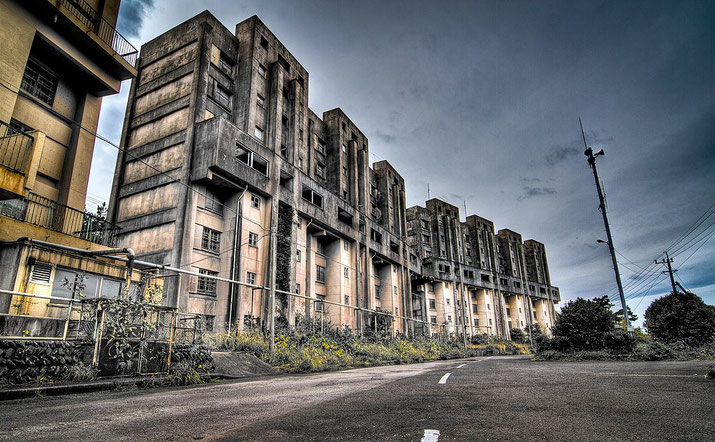
Millions of visitors to get the travel info from our web, we have had several requests to feature some island in Nagasaki. In this article, we explain the background of Ikeshima, how to get there and where to stay (there is only one place to stay!).
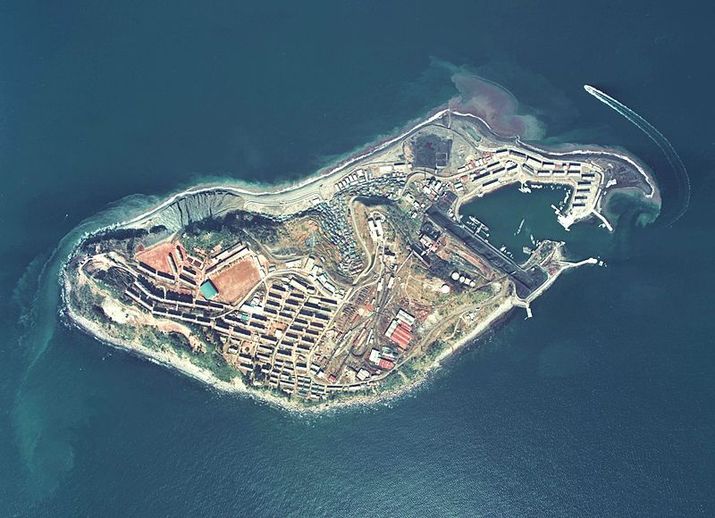
What is Ikeshima Island?
Asahi News featured the last day of the last restaurant called Kaachan no mise ("Mother's shop")on Ikeshima island which closed on March, 2023.
In 1913 Mitsui Mining company bought the area on a small island in Nagasaki for coal mining.
The excavation started in 1959. At that time the mining worker's salary was double of the normal office workers in Japan. The tall apartments were built for the workers. In 1985 the coal production reached its highest point of over 1.5mil tons. There were several accidents in 90s and due to the cheap coal from overseas, the coal mine was shut down in November, 2001. Around 2,500 workers were all let go. The legacy from the good and old time became partly ghost town.
Today around 200 people reside on the island.
<< If you are interested in cool islands from Japan, you find more from this complete list! >>
The island is called Ikeshima island (池島). It is the last coal mining island in Kyushu area.
Part of the old mine is used as the coal mine training center where around 60 people from Indonesia and Vietnam learn the safety and know-how of mining every year.
The island is a popular tourist spot in Nagasaki. The island provides a tour where you go in the mining tunnel and you can go through the old apartments.
It is not as popular as Gunkan island (Hashima island in the same city as Nagasaki) which is a bit more complicating to get than Ikeshima island. If you are looking for a relaxing and easy tour to a mysterious island, this is great. You can only stay for 30 mins or so on Gunkan Hashima island but you can stay OVER NIGHT on Ikeshima island.
As to the tour on the island
If wanting to join the local tour for the coal mine, you need to book it from this website( in Japanese) at latest 3 days in advance .
High school student or older 2720JPY Primary school and Jr High school student 1360JPY
( younger than primary school students(5 years old or younger) are not allowed)
Need to wear sneakers (no sandal or high heels).
You can also order the coal mine lunch box. You need to reserve it 3 days in advance. Call +81 959-26-0888.
There are several tours including island tour. For more details, please ask the tour organizer from this mail form or Tel: +81 959-26-0888
Some people staying on Ikeshima island over night and reporting about their experience there.
How to get Ikeshima Island

If coming from Tokyo, better stay in Sasebo 1-2 days before you leave for the island.
From Tokyo, 1) you fly from Haneda airport to Nagasaki airport. It is around 6 hours to get Sasebo port( which is 5 mins by taxi from JR Sasebo station ) or 2) you take bullet train and change in Hakata to a local express to Sasebo. It is around 8 hours.
By air or ground, you need to book around 7 hours before you reach the port to get to the island.
Take a ferry from Oseto port (大瀬戸港)
frequency is good. Ferry which can carry cars. Stable way of travelling.
7 times a day starting at 06:40AM from Konoura port. The last ferry is 18:40 departing Ikeshima port. 440JPY for adult and 220JPY for child 30 min trip in total
( Except for High speed ship 590JPY for adult (300JPY for child) 10 min trip
Take a high speed ship from Sasebo port (佐世保港)
Sasebo port is a big port and easy to get. The ship goes only 2 times a day 07:22AM from Sasebo port and the last one is at 16:09 departing Ikeshima port. 1910JPY for adult ( 960JPY for child) around 1 hour trip
Take a boat from Konoura port (神浦港)
It is a boat. Sometimes to be cancelled due to the weather. 7 times a day starting at 06:45AM from Konoura port. The last boat is 17:35 departing Ikeshima port. 350JPY for adult and 150JPY for child 15 min trip in total
( Except for Ferry 410JPY for adult (210JPY for child) 27 min trip and High speed ship 560JPY for adult (290JPY for child) 10min trip
Note: Ship leaves on time. It does not wait for you if you are even several second late! Be on time!
some questions about ikeshima island? (Updated 2024)
Some examples...any atm where to stay.
Q: Can I stay overnight on Ikeshima Island?
A: Yes but the Ikeshima Island Central Hall (池島中央会館) is your only option.
Q: Any ATM on the island?
A: No. You need to bring cash before you leave the port.
Q: Can I drive to Ikeshima Island? Can I drive around once I am there?
A: Yes, you can take your car on the ferry to Ikeshima Island. And once you are there, you can drive around, though there are some places you can't go.
Q: Are there any shops or places to eat on Ikeshima Island?
A: As of April 2024, there aren't any. And there's no place to grab snacks or groceries at Kanura Port, so heads up. But there are shops and convenience stores around Seto Port.
Also, keep an eye out for days when you can order the coal mine bento box (called Tanko Bento 炭鉱弁当) 900JPY with tea (they only take orders on weekends and holidays). You need to reserve 3 days in advance.
Where to Stay on Ikeshima
So where is this ikeshima central hall.
There is only one place to stay over night on the island. If you want to spend a night on the island, choose this one.
Name: Ikeshima Chuo Kaikan ( 池島中央会館 )
How to book: Book by phone +81 959-26-2030 (08:00AM-21:00)
Note: No food provided. There are several types of rooms from two single rooms till the big room for 8-15 people. It is possible to stay with no booking if the room is available on your visit ( But recommend to book in advance!)
More hotels in Sasebo city
We will update you some other options to stay. For example, we have some recommendations for Sasebo city, a very big city with more options of restaurants and bars, famous for Sasebo Burger.
Basically, if you look for a comfortable stay, you should stay in Sasebo city, not on the island!
want to shoot TV or youtube video etc. on ikeshima island?
Our media support as fixer and japan side producer.
Do you want to TV shooting, music video, photo shooting on the Ikeshima island in Japan? Interviewing the city mayor about the island? Want to interview the local people on the island?
We worked with major TV broadcasters around the world and online media to carry out their task in Japan. We make planning, arrangement with the venues, also hire local professional crew (videographer, photographer, editor, makeup artist, stylist, model, interpreter etc. ) for the project.
Just contact us.
Note: Please fill out the fields marked with an asterisk.
Onegai Kaeru wants you to enjoy Japan trip.
If you are looking for more traveler"s info and can not find one, please let us know. We will try to help you with Japan Traveler Help Service (we work on hourly charge to arrange, book, find info you need). Feel free to contact us!
Do you know an island with over 2000 years old tree in Japan? Please check this out!
Onegai Kaeru , a group of passionate travelers, bring happiness to the world with its shopping support service and original super cute items !
Source: Wikipedia, Nagasaki city official website
Disclaimer: Even though we try to make the info as updated and accurate but the accuracy of the information herein is not guaranteed by us. If you have any uncertainty, please contact the information source.
Write a comment
Elvira ( Monday, 29 August 2016 22:35 )
Thank you for this information! It is possible to bring the car on the ferry from Sasebo to Ikeshima and then to Konoura? Thank you for your advice! Elvira
Laird Small ( Monday, 04 June 2018 20:28 )
What times does the ferry leave Oseto for Ikeshima island?

Ikeshima Island 池島島
A playground for japanese ruins enthusiasts....
To play, press and hold the enter key. To stop, release the enter key.

Once home to a small community of approximatley 300 people, the tiny island of Ikeshima was dramatically transformed in 1959 upon the discovery of an abundance of coal beneath its surrounding waters. A large underground mine was developed along with a number of factories and living quarters which catered to the islands bustling population. B ut years later in 2001, cheaper coal imports from overseas led to the mines decommissioning and, eventually, the permanent closure of Nagasakis last island based coal mine.
At its height, Ikeshimas population reached 8000, now as of 2016, its numbers sit at around 160 - a figure that still dwindles as a result of almost non-existent employment opportunities. Currently the islands only active amenities include one shop, a very small civic center (which only operates on selected days), a school that apparently still operates for a tiny number of students (6 in total at the time of my visit) and an abundance of abandoned buildings.
Ikeshima is filled with rows and rows of brutalist cement style housing complexes, most of which were utilised as homes for Japanese workers and families along with Indonesian and Vietnamese miners. Now left to ruin and decay, they sit in silence, engulfed by kudzu vine and nature as the years slip by.
When discussing the aesthetics of abandonment and the visual appeal of urban decay, Ikeshima is nowhere near as glamorous as its famous sister island Hashima. However it holds an interest in the sense that the observer can engage with more recent lingering emotional traces of the late 90’s. Such traces can be found inside the islands empty, sinister hospital filled with rusting medical equipment left to rust and decay. This includes a creepy morgue, a foreboding operating theatre that looks as if the surgeons just decided to leave half way through a procedure, a number of hospital wards reminiscent of a horror movie and, lastly, a torturous looking dental ward. An abundance of surgical items still sit on shelves including plaster dentures, metal plates, pliers and drills. Calendars indicate that the hospital began to dwindle around 1996 with its final and permanent closure in 2001. One would ask themselves how so much expensive medical equpiment could be left to rot away in the dark?
Other areas of the island are equally interesting such as the recreational center, where you can find a poolroom, gymnasium, community hall adorned with Indonesian and Japanese flags and many offices filled with television sets and 90’s electronic devices.
Still smelling strongly of oil and gasoline, the islands many work areas rust away in silence as birds and spiders make new homes in its nooks and crannies.
Recently reopening its disused 300 meter deep mine for tourism (a three-car train carries up to 27 passengers), Ikeshima has seen a rise in visitor numbers. But the island now attracts a different style of tourist...becoming a playground for Japanese urban explorers and ruins enthusiasts.
- 1 Understand
- 3 Get around
Ikeshima (池島) [1] , also known as Ike Island , is a small island in Nagasaki , Japan .
Understand [ edit ]
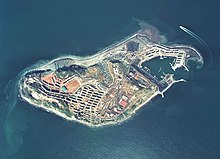
The last open-pit coal mine in Japan, Ikeshima housed nearly 10,000 people at its peak, but closed down in 2001. A little over 100 people are left now, mostly tending to a nascent tourist industry of people visiting the ruins.
The island is often compared to nearby Gunkanjima (Battleship Island) of James Bond fame, but is far less well known and, as a (barely) living community, is much more freely accessible. The mine areas are still marked off and can legally only be accessed on guided tours.
Get in [ edit ]

The island is served by 7 daily ferries from Konoura port (神浦港) and 6 from Seto port (瀬戸港), a frankly absurd level of subsidized service given the tiny population. Fares range from ¥370-570 and travel times from 10-26 minutes depending on the ship, see Kanko Sotome [dead link] for schedules.
Both ports can be reached by bus from central Nagasaki, but you will need to transfer at Sakuranosato Terminal (桜の里ターミナル) and the trip will take at least 1.5 hours.
Get around [ edit ]
There is one bus route on Ikeshima, starting near the ferry terminal and ending near the far west of the island. However, Ikeshima is small and can be easily traversed by foot.
See [ edit ]
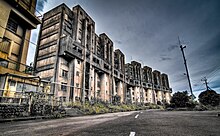
The main/only reason to visit the island is the "ruin porn" of seeing abandoned or semi-abandoned buildings slowly being taken over by nature.
Do [ edit ]
- Mine tour . Two-hour tours of mine, two times a day, including a ride on the mine "trolley" train. Intended for Japanese speakers. Book at least one day in advance. ¥3170/1580 adult/child, plus ¥900 for a "miner's bento" for morning tours only. . ( updated Feb 2023 )
Buy [ edit ]
Eat [ edit ].
- Kaachan no Mise ( かあちゃんの店 ). "Mommy's Shop" is the only public eatery on the island. ( updated Feb 2023 )
Drink [ edit ]
Sleep [ edit ].
There is exactly one place to sleep on the island, and it's not much. Most visitors opt to day-trip from Nagasaki.
- Ikeshima Chuo Kaikan ( 池島中央会館 ). Spartan lodging at the community hall. ¥3446/night, no meals . ( updated Feb 2023 )
Connect [ edit ]
Go next [ edit ].
- Has default banner
- Has mapframe
- Articles with dead external links
- Do listing with no coordinates
- Has map markers
- Eat listing with no coordinates
- Nagasaki (prefecture)
- All destination articles
- Outline cities
- Outline articles
- City articles
- Has Geo parameter
- Pages with maps
Navigation menu
Ikeshima Coal Mine
Spot details.

Information Sources: NAVITIME JAPAN
Nearest spot
Related information.
インバウンド旅行者向け広告掲載について
- NEARBY ACTIVITY -
![ikeshima island tour [Nagasaki, Nishiumi] Experience diving ♪ Play on a private boat + snorkeling + underwater scooter ♪](https://img.activityjapan.com/10/9770/10000000977001_pvonuId9_4.JPG?version=1712495467)
Share this spot

Copy to clipboard completed.
プライバシーポリシー ・ 利用規約 に同意の上、ボタンを押してください。
ログイン(無料)すると より便利に利用できます
Change password
Ikeshima Coal Mine Course

- See all photos
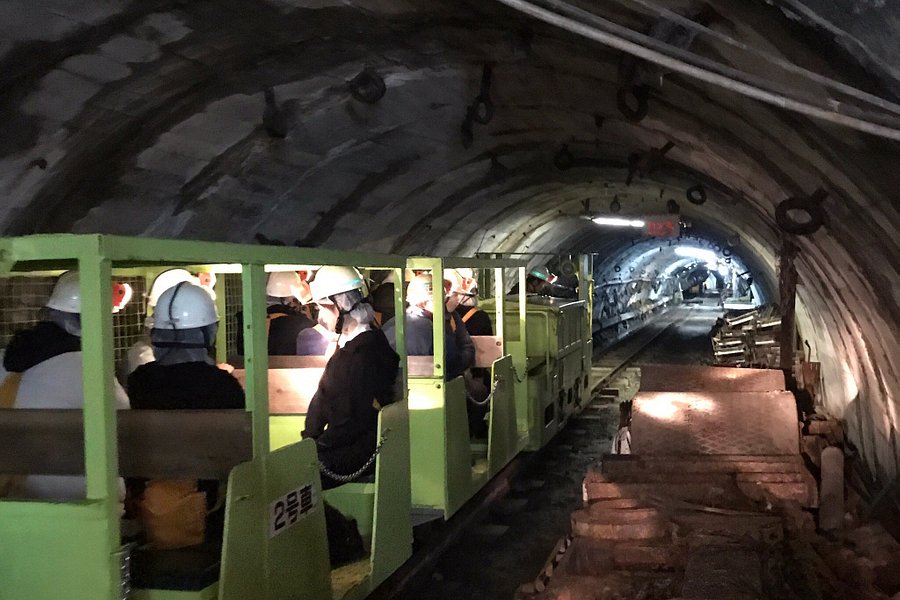
Similar Experiences

Most Recent: Reviews ordered by most recent publish date in descending order.
Detailed Reviews: Reviews ordered by recency and descriptiveness of user-identified themes such as waiting time, length of visit, general tips, and location information.
IKESHIMA COAL MINE COURSE (Nagasaki) - All You Need to Know BEFORE You Go
- Japan Tourism
- Japan Hotels
- Japan Bed and Breakfast
- Japan Vacation Rentals
- Flights to Japan
- Japan Restaurants
- Things to Do in Japan
- Japan Travel Forum
- Japan Photos
- All Japan Hotels
- Japan Hotel Deals
- Last Minute Hotels in Japan
- Things to Do
- Restaurants
- Vacation Rentals
- Travel Stories
- Rental Cars
- Add a Place
- Travel Forum
- Travelers' Choice
- Help Center
Hashima Island and Ikeshima Island - Japan Forum
- Asia
- Japan
Hashima Island and Ikeshima Island
- United States Forums
- Europe Forums
- Canada Forums
- Asia Forums
- Central America Forums
- Africa Forums
- Caribbean Forums
- Mexico Forums
- South Pacific Forums
- South America Forums
- Middle East Forums
- Honeymoons and Romance
- Business Travel
- Train Travel
- Traveling With Disabilities
- Tripadvisor Support
- Solo Travel
- Bargain Travel
- Timeshares / Vacation Rentals
- Asia forums
- Japan forum

Would you recommend it? I think I am more interested in Ikeshima Island as I prefer the freedom to explore the island. Do you know if it is difficult to get to?
If you prefer the freedom to explore, Hashima is not it. As the buildings are literally collapsing it is very dangerous and the only recent exploring I know of was done by drone - not in person. The area the public is allowed to visit on the island is very limited and controlled.
Still, my visit in 2019 I enjoyed a lot - was not allowed onto the island due to typhoon damage, but still worthwhile due to my interest in the place.
https://en.wikipedia.org/wiki/The_Battleship_Island
When freedom is in high priority, industrial heritage sites like these do not look like good choice.
This topic has been closed to new posts due to inactivity.
- Express bus to Oshino Hakkai 1:04 am
- Stay in Kyoto train station or another area in Kyoto? 1:00 am
- Sashiko shopping 12:59 am
- Hierarchy: Mimaru, Monday, Minn, MyStays, Sakura 12:50 am
- Narita to Haneda connection - unconnected tickets Saturday. 12:48 am
- Help! How to reserve Yufuin No Mori tickets? 12:37 am
- Kyshu travel for 2 in Nov 2024 12:04 am
- Izu peninsula 11:49 pm
- Vegetarian Ryokan for Family 11:44 pm
- Shari Bus 11:19 pm
- Flowers in May? 11:02 pm
- Peace Park- tickets in advance? 10:55 pm
- Best Shinkansen from Tokyo Station to Kyoto Station 10:52 pm
- Kanazawa, Toyama, Takayama area 10:36 pm
- 'semi double' rooms 5 replies
- Pocket WiFi Rental Experience? 315 replies
- kyoto-takayama JR or Lmtd express??? 6 replies
- Best Japan travel guide book? 29 replies
- Best/cheapest time of year to visit?? 3 replies
- Radiation danger in Tokyo? 37 replies
- Best Skiing in Japan? And When? 3 replies
- Japan in 10 days 3 replies
- How far is Nara from Kyoto 8 replies
- how to get to Hokkaido from Tokyo? confused..pls HELP. 5 replies
- 2024 public holiday chart in East Asian countries
- Where can I find more onsen in Japan?
- Driving Information
- Catholic mass in English and other languages
- How can we access tourist attraction from cruise port?
- Pocket WiFi Rental Experience?
- Halal Information
- Tokyo trip report here
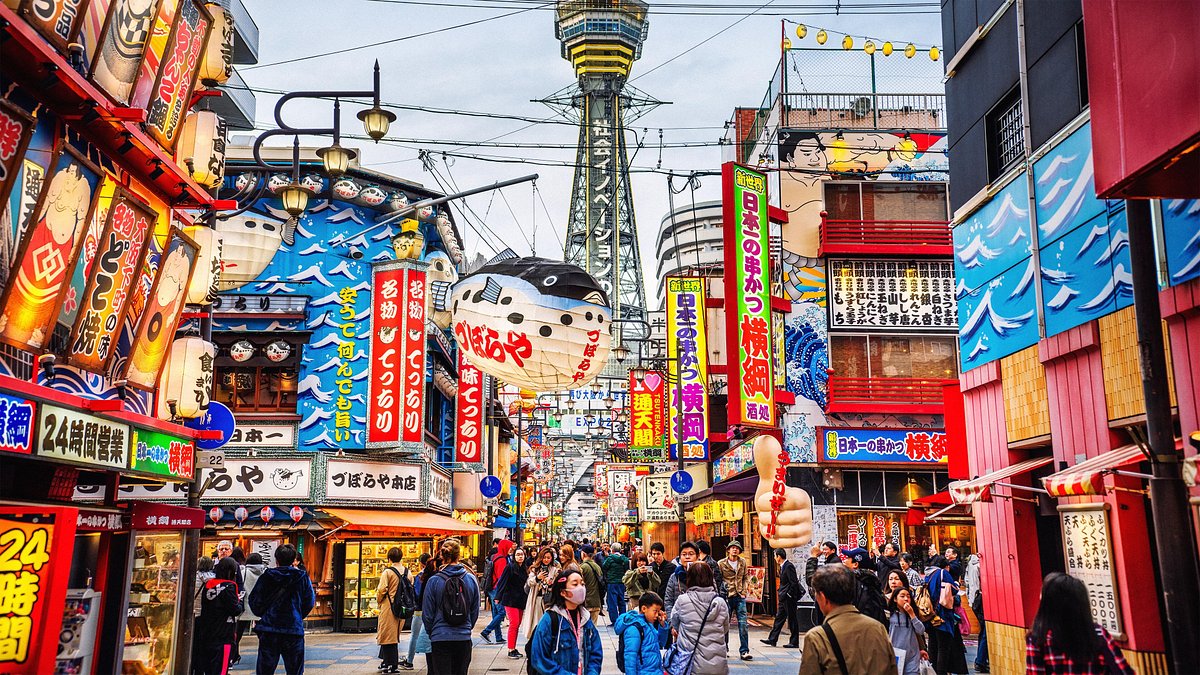
- Subscribe Digital Print

- LDP funds scandal
- Latest News
- Deep Dive Podcast
Today's print edition
Home Delivery
- Crime & Legal
- Science & Health
- More sports
- CLIMATE CHANGE
- SUSTAINABILITY
- EARTH SCIENCE
- Food & Drink
- Style & Design
- TV & Streaming
- Entertainment news
Former coal mining island Ikeshima hopes unique tours ensure survival
A tiny island housing Japan's only decommissioned coal mine that visitors can walk around in has struck the tourism lode amid rising public interest in industrial heritage.
At its peak, during Japan's postwar growth spurt, the island was home to some 8,000 men, women and children living in vast apartment complexes.
But it lost the fight in an era of cheaper imported coal. Most families left, and the population plunged to about 160.
In 2011, the island revived the mine carts for guided tours inside the mine.
A three-car train carries up to 27 passengers 300 meters inside. Visitors then get off the train and walk further inside the pit. Ikeshima is the only former coal mine in Japan that permits tourists to enter on foot.
"We would like to create an environment which encourages tourists to visit repeatedly," said Hidemi Kondo, 65, who runs a souvenir store near the mine entrance. "This island has no other choice but to survive on tourism."
Some visitors were clearly impressed with the tour.
"Pipes remain as they were," said visitor Daichi Inoue, 19, from Fujisawa, Kanagawa Prefecture. "The tour was a rare experience for me."
Increasing interest in Japan's industrial heritage has been a boon to Ikeshima. Other sites enjoying the attention of tourists include the isle's more famous sibling Hashima Island, commonly called Gunkanjima (Battleship Island), also in Nagasaki, which was designated a UNESCO World Heritage site in July 2015. It is part of "Sites of Japan's Meiji Industrial Revolution: Iron and Steel, Shipbuilding and Coal Mining," a cluster of locations in varying states of preservation.
About 4,500 tourists took trains into the Ikeshima mine in 2014 and the total for 2015 is estimated to have topped 7,000.
Tours were added in 2015 to include such locations as the miners' now-vacant apartment complexes to develop tourism further.
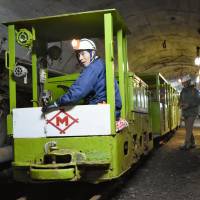
In a time of both misinformation and too much information, quality journalism is more crucial than ever. By subscribing, you can help us get the story right.
- Tokyo Cheapo (繁體中文)
Touring Abandoned Hashima Island (Gunkanjima or Battleship Island)
You’ve seen it in Skyfall and all over the media. Now a UNESCO World Heritage Site, Hashima Island — also known as Gunkanjima (“Battleship Island”) — has attracted attention for its post-apocalyptic, modern ruins. Here’s everything you need to know before visiting this Nagasaki prefecture destination.
Where is Gunkanjima?
What happened on hashima island.
- Things to know before visiting Battleship Island
Getting to Nagasaki
- Making sure you have the right island in mind
Note: As of September 25, 2019, boat tours are unable to land on the island due to damage caused by a typhoon. However, boats can still take you near the island. -->
Hashima Island (aka Gunkanjima) is located 12 miles (19 km) off the coast of Nagasaki . Nagasaki is located on the east coast of the island of Kyūshū, the southernmost of Japan’s four major islands.

As a world-class undersea mining operation, the island was once a symbol of Japan’s rapid industrialization. Mitsubishi bought the then uninhabited island in 1890, and soon it was transformed with modern buildings and conveniences. These included early examples of concrete apartment blocks and electric lighting. By the 1950s, the population had swelled to as many as 5,000 people, attracted by solid wages and a unique mining culture.
However, as coal power gave way to gasoline, coal prices fell, and many mines, including Hashima, were permanently closed. By 1975 the island was completely evacuated.
An abandoned Japanese island with a shady past
Hashima Island’s increase in popularity and status as a World Heritage Site, though, has not been without controversy. What many don’t know is that the island has a history of forced labor , both before and during World War II. The terrible conditions and unsafe environment led to untold suffering — along with as many as a thousand unrecorded deaths. Tour companies are often reluctant to talk about this, leading to suggestions that those in power are attempting to obscure the island’s history.
At the time of writing, Gunkanjima had no memorials to the victims of forced labor. Japan has pledged to set up a memorial and an information center in the years to come.
From local eyesore to world-famous attraction

Thanks to a total ban on visitors, Hashima Island was left to be reclaimed by what little nature remained — and remained practically untouched for decades. The eerie atmosphere of an industrial town where people seemingly disappeared mid-lunch eventually caught the public eye. Slowly but surely, brave individuals started returning to the island, exploring and taking photos.
However, the crumbling ruins — not to mention abandoned mines — meant that unregulated visits were an accident waiting to happen. Perhaps to combat this danger, official guided tours were eventually introduced.
Since the Japanese government lifted the ban in 2009, the island has become a popular destination for visitors to Nagasaki and Fukuoka . To cater to demand, several companies have begun offering guided tours, departing from Nagasaki Port. Prices range from about ¥ 3,900 to ¥ 5,100 per person.
Important things to know before visiting Battleship Island
If you want to visit Hashima Island (aka Gunkanjima aka Battleship Island), here are some things to know beforehand.
1. You can’t visit Hashima Island on your own

Safety first is the key principle here! Even though Hashima Island is one of Nagasaki’s top attractions, the buildings on the island really are at risk of crumbling. And since no one knows when they might crumble, the government has mandated that tourists can only visit as part of an official tour group. Unless you’re in journalism or media in general, sorry, that solo trip just isn’t happening.
Pro tip: [affiliate id="japanican" text="This tour to Battleship Island" link="https://www.japanican.com/en/tour/detail/ACT1J05004QQB/?typecd=TOU&kw=Battleship&typegrpcd=TPA"] is pretty good.-->
2. Nagasaki weather gets pretty rough
Gunkanjima is surrounded by treacherous waters. The sea is harsh, and even a slightly rainy, cloudy, and/or windy day is enough to set off the waves and impede visibility. Consequently, cruise companies reserve the right to cancel tours due to bad weather — even on the day of the tour itself or while you’re aboard the ferry.
In the case that the tour is canceled outright before it starts, you should be eligible for a refund. Sometimes tours depart Nagasaki only for conditions to worsen mid-journey. If it becomes no longer possible to dock at Hashima Island after you’ve departed, the tour will likely pivot to a cruise around the island instead — and you’ll be refunded the difference in cost.
In any case, just keep in mind that there’s always the risk of the tour not pushing through for reasons beyond human control. For reference, Yamasa Shipping’s website mentions that on average, the number of days in a year that tours successfully push through is around 100.
3. Gunkanjima is not for the faint of heart

See the above point on Gunkanjima’s waters. More than the cost, the major obstacles to visiting Hashima Island are inclement weather and health. If you’re prone to seasickness and motion sickness, this probably isn’t the tour for you. On a particularly rough day, even those who don’t easily suffer from those conditions may also feel unwell. I don’t get motion sickness easily, but there were several times when I felt like throwing up, and I finally did during the ride back.
Having anticipated that guests might feel uncomfortable on the journey, the staff distributed towels, candy, vomit bags, and even a wristband that’s supposed to help combat motion sickness, but those still weren’t enough for me. (They don’t sell anti-motion sickness medicine, though, so bring your own just in case.)
If these don’t discourage you, then good for you! But just remember that your health is more important than any tour, however awesome it may be. In my case, it was a short but memorable experience, but would I do it again? I don’t think so, because of the bumpy ride!
Editor’s note: Motion sickness medicine in Japan is called yoidome (酔い止め) and it can be purchased at any major drug store chain.
4. You may be refused admittance based on your physical condition

This isn’t because of discrimination; again, it’s for safety reasons. The tour companies we list don’t reject reservations from pregnant women, as well as people with disabilities and chronic illnesses. However, harsh weather conditions and other unforeseen circumstances could still lead to pregnant women suddenly being barred from joining a tour.
Unfortunately the ferries are not wheelchair accessible , and Gunkanjima isn’t a wheelchair-friendly location, either. Those with serious chronic illnesses are also discouraged from joining. It’s best to inform the tour companies beforehand about any physical conditions you have, just so you have an idea of whether you can go ahead with that reservation.
5. Babies and pets are not allowed
We’re not sure why anyone would think of bringing a baby or a pet on a tour like this, but if you’re thinking about it, don’t. No tour operators allow kids under 3, and they really prefer kids to be in elementary school and up. Some will let you book for preschoolers, but others won’t.
Part of this is because of Nagasaki law, which says children under 6 can’t be on the deck of the boat. So if you’re traveling with a child aged 3–6, you’ll have to remain seated with them inside the boat at all times — rather than crowding on the deck with everyone else trying to get photos. And there is still a chance the captain can decide it is too unsafe for a preschooler to disembark.
6. You have to sign a safety contract

You have to agree to follow their rules, which are basically common sense anyway: don’t join the tour intoxicated; don’t go off on your own upon disembarkation (yes, following the guide is really important; they need a license to conduct those tours so they know better) — things like that.
Pro-tip: Read more about haikyo (Japanese for “ruins” but usually referring to modern ones) as an exploration of Japan, past and present
7. There’s an additional ¥ 310 fee on top of the tour cost
It’s a fee set by the local government and it goes to the preservation of Gunkanjima. You pay this to the tour company, with some including it in the price and some charging seperately. For children the fee is ¥ 150 .
8. The Hashima Island tour is 60 minutes long — max

Again, this is a government-mandated thing, and it’s for everyone’s safety. You’ll follow a guide down a prescribed route and stop for photo ops here and there. You won’t really see much of the island, but you’ll at least get a glimpse of the urban decay. And no, you can’t get close to, let alone explore, the ruins. Safety first, remember?
Yes, the round trip to the island takes longer (as just going one-way can take up to an hour, depending on conditions), and while this may be a letdown for some, keep in mind that there’s no other way you can see Gunkanjima. It’s not like it’s some tourist spot in Tokyo , Kyoto , or Osaka that’s easy to get to. And, hey, it’s better than nothing!
9. Skyfall wasn’t actually filmed there
The island was famously featured in Skyfall as the lair of Raoul Silva (a former MI6 agent gone rogue). In reality, the abandoned island just inspired the eventual design of the film, which was actually shot in Macau. So while the reputation for villainy stands out for tourists, only external shots were ever shown in the film. The island was, however, used as a filming location for the less-acclaimed Attack on Titan film, back in 2015.
Tours to Hashima Island

Depending on the company, you might see tours listed for “Battleship Island”, “Abandoned Japanese Island, “Skyfall Island,” or “Ghost Island.” But when it comes to what you see on Hashima Island, all tours are the same. Only a small section of the island is open to visitors, and you’ll be joining a guided tour (with probably 15–30 other people) along a prescribed route.
The time you get on the island is also the same across tours: about 45 minutes — or an hour at max (depending on the ferry crossing conditions). All tours require advanced reservations, which can be done online.
Gunkanjima tour guidelines
- Dress appropriately: Be sure to wear trainers/sneakers (and definitely not heels! but also: no sandals) and some kind of sun protection, as there is little shade on the island; also be warned that it can be very windy, especially in winter.
- Rain doesn’t necessarily mean tours won’t run. Note that umbrellas (and parasols) are not allowed on Hashima Island, so bring a rain jacket if the sky looks questionable. Operators will probably also have plastic ponchos for sale/rent/or maybe for free.
- There are no toilets on the island, and only one or two likely on the boat, so plan accordingly!
- You can take photos and videos on the island and during the journey over (though some operators may ask that you don’t film the guides), but absolutely no drones.
Hashima Island tour companies
All of these are operators licensed, so don’t worry — you’re in good hands.
Note that all of the tours below leave from different locations, but all can be easily reached from Nagasaki Station, either by tram or on foot. Be sure to arrive 30–45 minutes before departure time (following the instructions for the operator) to complete the check-in process.
Yamasa Shipping Co. Ltd.
9 a.m. and 1 p.m daily ¥ 4,200 per adult
Yamasa Shipping Co. Ltd. tours are the priciest on our list but they do come with a considerable perk: guides who speak English or Chinese.
English guides are available on Tuesdays, Thursdays, and Saturdays, while Chinese guides are available on Mondays, Wednesdays, Fridays, and Sundays (let’s hope you don’t have a mixed group of friends!).
If you book online in advance, you can often score a 5–10% discount. Tickets are also a few hundred yen cheaper for junior high and high school students; meanwhile children 6–12 can join for half the adult fare.
Tours last around 2.5 hours, about two-thirds of which is spent on the boat — but that’s pretty standard. Remember, there’s lots to see from the ferry as well!
Additional details
Booking link 095-822-5002 Nagasaki Port (meet at window no. 7, Nagasaki Port Terminal Bldg.) Tram line 1 to Ohato or a 15-minute walk from Nagasaki Station

Gunkanjima Concierge
9 a.m. and noon (or abouts) daily ¥ 5,000 to ¥ 5,500 per adult (includes entry to Gunkanjima Digital Museum)
Gunkanjima Concierge tours include admission to the Gunkanjima Digital Museum , which is value of ¥ 1,800 (for an adult ticket). So if you’re keen to do both then this tour is the best value for money. The museum is pretty cool and includes VR experiences, projection mapping, and interviews with people from the island along with items, photos, and a short film.
Tours depart from the museum. If you opt for the morning tour, meet up time at the museum is between 9 and 10 a.m. — which means you can visit the museum then, or afterwards. For the afternoon tour, check-in time is between 10:30 a.m. and 1 p.m., which gives you plenty of time at the museum.
The tours have audio guides for foreigners as the tours are conducted in Japanese. They boast an impressive 94% landing rate and a 91% departure rate.
Gunkanjima Concierge ticket classes
This cruise is a little different from the others in that there are different ticket classes. Ticket class determines your ferry experience — not the island tour, which is the same for everyone.
- Super Premium: Reserved window seat above deck; priority boarding and disembarking; access to a second floor deck for photo-ops
- Premium: Reserved center seat above deck; priority boarding and disembarking; access to a second floor deck for photo-ops
- Standard: Unreserved seat below deck
Gunkanjima Concierge ticket prices
Peak days are defined by the operator as national holidays, Golden Week, summer vacation, and winter vacation. But since you’re booking ahead there shouldn’t be any suprirses.
There are concessions for junior and highschoolers ( ¥ 1,000 discount) and also elementary school kids ( ¥ 3,000 discount for super premium and premium class or ¥ 2,500 discount for standard class).
Preschoolers ( ¥ 1,500 / ¥ 2,000 weekdays/weekends) can only ride standard class, as they must stay below deck for the duration of the trip.
Booking options: Direct via the operator or via Klook 095-895-9300 Tokiwa Port (meet at the Gunkanjima Digital Museum) Tram line 5 to O-Urakaigandori (30 min from Nagasaki Station + 1 transfer)
Note: Klook does not seem to have the same refund policy as the operator should cruises be canceled.

Gunkanjima Cruise
9:10 a.m. and 2 p.m. daily ¥ 3,600 per adult
Gunkanjima Cruise is the cheapest option, costing just ¥ 3,600 for adults (and ¥ 1,800 for children 12 and under). No tiered pricing or add ons — just a simple flat price.
Tours last a little over 3 hours, and actually visit two islands: Takashima and Hashima. First you’ll sail 40 minutes (ish) to Takashima, where you’ll have 30 minutes to visit the island’s Coal Museum. The highlight here is a scale model of Gunkanjima; there are also some artefacts that shed some light on the life of the miners.
Then it’s a 15-minute ride to Hashima Island, where you’ll have 45 minutes or so of guided viewing of the island.
There is one major downside: no English-language tour guidance. So you’ll be following a tour led in Japanese (you can’t just go off on your own, even if you don’t understand).
Cruises depart from Motofuna Pier, which is a short walk from the Ohato tram stop. Be sure to arrive at least 20 minutes before departure for pre-departure procedures such as registration and payment.
Booking link 095-827-2470 Motofune Pier (11-22 Motofunamachi, Nagasaki City) Tram line 1 to Ohato or a 15-minute walk from Nagasaki Station

Visiting Gunkanjima requires first getting to Nagasaki , which is in Kyūshū. There are international flights to Nagasaki Airport from Shanghai and Hong Kong. Otherwise your only option is to come from elsewhere in Japan. Fortunately, Nagasaki is a major city served by frequent domestic flights, trains, and buses.
Flying to Nagasaki
There are domestic flights to Nagasaki Airport from Tokyo (both Narita and Haneda), Kansai International, Osaka Itami, Kobe, Nagoya Chubu, and Naha.
Both Japan Airlines and All Nippon Airways have discounted fares for foreigners who can show proof of residence outside Japan and a ticket back home. If you’re eligible, the fare is ¥ 11,000 for one-way for flights to Nagasaki.
If you want cheaper than that, look into Japan’s low-cost carriers . For example, Peach Air flies to Nagasaki from Osaka’s Kansai International Airport for as little as ¥ 4,000 one-way. The journey is just over an hour.
Alternatively, you can fly to Fukuoka from Kansai (about 1 hour, also for around ¥ 4,000 one-way for Peach) or Tokyo (about 2 hours, starting at around ¥ 5,000 one-way), then take a 2-hour bus (for about ¥ 2,500 ) to Nagasaki.
Unfortunately, getting from Nagasaki Airport to Nagasaki isn’t super convenient, requiring an hour-long bus journey or a pricey taxi ride.
The New Nishikyushu Shinkansen
Trains are an option, especially now that Nagasaki has a Shinkansen station. If you’re traveling with a JR Pass , getting to Nagasaki from anywhere in Japan won’t cost you any extra.
Since September 2022, the the brand new West Kyūshū Shinkansen began service between Takeo Onsen and Nagasaki. Unfortunately, the line isn’t linked up the rest of the Shinkansen network (because of some drama), so you have to take a Ltd. Express train between Takeo Onsen and Fukuoka. It’s annoying extra transfer, though the new Shinkansen does make the trip 30 minutes quicker.
There are also overnight buses from various areas in Kansai.
Make sure you have the right island
We’ve seen quite a few mis-spellings online for Hashima. The most common is “Nashima”. Presumably people are getting it confused with the famous art island of Naoshima , which believe us could not be more different.
While we do our best to ensure it’s correct, information is subject to change. This post was first published in March, 2015. Last updated in April 2023.
- Hashima Island
- Japanese history
Get the best Japan Cheapo hacks direct to your inbox

Complete Guide to the Hokkaidō Shinkansen
Where to go and what to do along Japan's northernmost bullet-train route.

10 Adrenaline-Pumping Okinawa Adventures
The options are plentiful, the prices low. Choose from jungle treks, wild camping, zip-lining and more.

A Matcha Lover's Guide to Kyoto
Love tea? Then you'll love Kyoto.

Updated: 2024 Japan Cherry Blossom Forecast
The blooms are fashionably late. Here's when to see sakura in all the major cities.

April 2024: Top Events Around Japan
Look forward to flowers and festivals galore!

8 Perfect Places To See Cherry Blossoms in Osaka
Castle grounds, sprawling parks — and somewhere extra special.

Cherry Blossoms in Kyoto: 14 Best Sakura Spots
From temples to riversides, geisha districts — and more.

9 Things To Do in Fukui
Explore the shiny new stop on the Hokuriku Shinkansen — an easy trip from Tokyo.

6 Must-See Fertility and "Penis Festivals" in Japan
Stop giggling and start reading.

11 Best Places to See Cherry Blossoms in Japan
Riverside paths, real castle moats, pagodas and more.

Ghibli Park Guide: Tickets, Getting There and More (Updated)
Now with the Valley of Witches, and real-life cat buses.

Osaka to Tokyo: The Fastest and Cheapest Ways to Get There
Handy information on your travel options between the two cities.

Recommended hotels located nearby

Close without accepting
Select your language
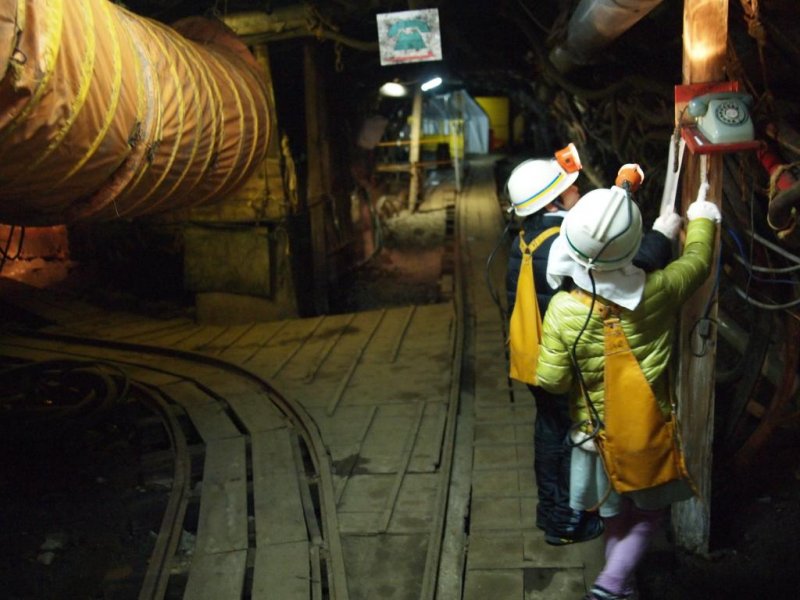
- Nagasaki City
Ruins of Ikeshima, Coal Mine Island
Urban exploration and industrial tour.
The island of Ikeshima, a day trip from Nagasaki or Fukuoka, lies on top of an enormous reserve of undersea coal. Starting in 1959, a local business began moving workers to the island to mine the coal, a lucrative operation that eventually moved 8000 men, women and children on top this absurdly tiny (600-meter radius) island. Vast apartment complexes from this period are still standing today and are open for your exploration. But you'll want to take the guided tour.
The mine was still going until 2001, when rising labor costs forced its closure (the coal is still there). Most families left the island, reducing the population to 300. The remainder eventually stumbled upon showing off the extraordinary industrial accomplishment that is Ikeshima to visitors. Their expert, first-hand knowledge of how life was lived here and of mining processes that were still carried on until 2001 guarantees you a safe, informative, and ridiculously fun experience. "Haikyo" ruin fanatics, cavers, and families will find this tour equally enjoyable.
Reservations should be made roughly a week in advance; the tour runs year round and is not affected by weather. Start your trip by taking a nearby ferry, which departs frequently. You'll be picked up in a bus and driven past the island's still-open institutions, such as a large school which once packed in 1000 students, but now hosts just 6 in the same building. While learning about the island's history, you'll be invited to visit the remains of the apartment complex that once housed thousands of mining families. Climb up to the rooftop and see the extent of an island transformed by man and reclaimed by nature.
After a traditional bento box lunch, prepared the way miners used to eat decades ago, it's time to ride into the undersea cave on a real mine car. Inside await experiences that will surprise children and adults alike. It's difficult not to emerge from the Ikeshima mine with a smiling face and a new appreciation for Japan's industrial heritage.
Visitors are also allowed on the island without a tour. A few restaurants, a supermarket, and a bar remain open, but on an irregular basis, and there are no hotels or hostels.
- Haikyo Urban Exploration
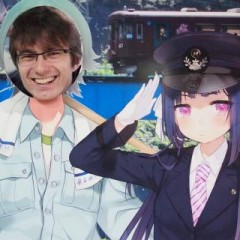
Avery Morrow @avery.morrow
Three years in Saga Prefecture have taught me that there is a lot more to this country than meets the eye.

Information

Nagasaki-ken Nagasaki-shi Ikeshima ( Directions )
Explore nearby
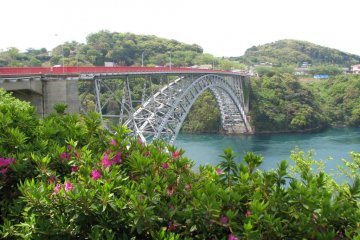
Rodan's Saikai Bridge
By Armand Vaquer

Sennari Sushi in Nagasaki
By Sleiman Azizi

Nagasaki Peace Park
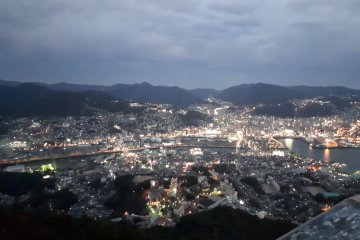
Mount Inasa Observation Platform
Top articles.
- Recommended


CRAFT SAKE WEEK 2024

King Tacos in Kin Town
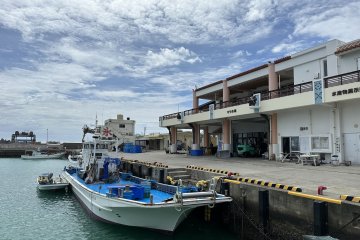
Uminchu Shokudo in Yomitan

Mikasa Matsuyama in Naha
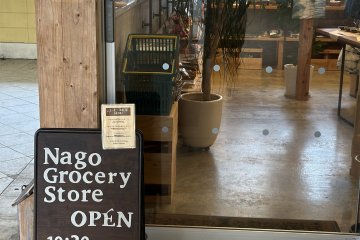
Nago Grocery Store
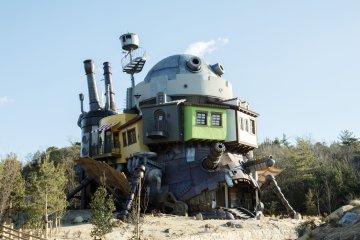
Valley of Witches: a New Ghibli Park Attraction

Mount Omuro

Night Walking in Azabudai Hills

M&C Cafe, Marunouchi
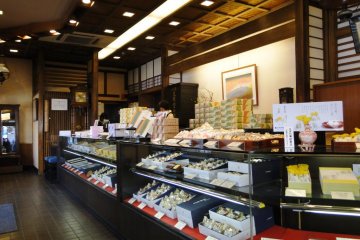
Bunmeido Castella Shop
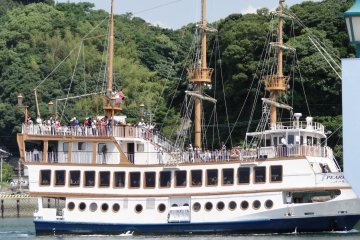
Kujukushima Cruise

Visiting Huis Ten Bosch
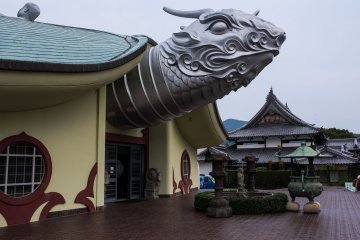
Fukusai-ji Temple

Hasami Porcelain

Huis Ten Bosch Hydrangea Festival
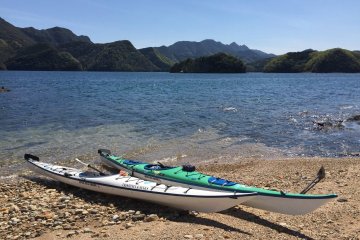
Local Living in Tsushima

The Beaches of Ojika Island
More from this category.
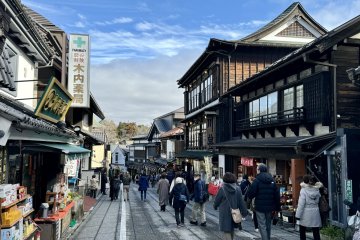
Narita City: More Than Just the Airport
By Veronica Carnevale

2024 Grand Sumo Tournaments
By Sébastien Duval
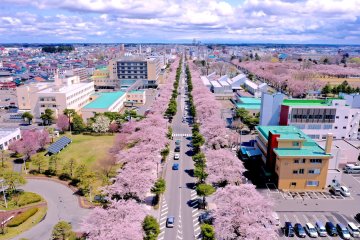
Towada City Spring Festival 2024
- Haneda Airport
- Okachimachi
- Shimokitazawa
- Kiso Valley
- Nozawa Onsen
- Shinanomachi
- Kumano Kodo
- Japan Journeys Style
- Things to do
- Restaurants
- Hiking and Walking
- Amusement Parks
- Animal Attractions
- Museums and Digital Art
- Parks and Gardens
- Sports and Stadiums
- Temples and Shrines
- Experiences
- Places to stay

- Destinations
- Things To Do
Explore the Decaying ‘Battleship Island’ on a Gunkanjima Cruise
I have a morbid fascination with abandonments. They are symbols of death, bankruptcy, modernisation and economic downturn. Their grimy shadows hide secrets, their decaying decor illuminates history and their silence speaks volumes. Oftentimes, once the decision has been made to walk away, these buildings, amusement parks and towns are frozen in time, defenceless against the unyielding forces of nature, forgotten. But not always. In some cases, like Hashima off the coast of Nagasaki, efforts are made to preserve and even promote the sites as tourist attractions . Those with a penchant for urban exploration should take a Gunkanjima Cruise out of Nagasaki City to witness the crumbling former coal mining island for themselves.
Hashima, a decaying bubble
Hashima, often referred to as Gunkanjima, or Battleship Island, due to its boat-like profile, is a UNESCO World Heritage Site located 15km from Nagasaki ’s city center. Coal mining kicked off here around 1887 and continued for nearly a century until 1974. At its peak, Hashima’s population was over 5,000 people; for such a small island—160m east to west and 480m from north to south—this made it the most densely populated place on Earth.
Though mining was the main industry, residents also had access to schools, shops , a hospital, cinema and swimming pool among many other facilities. It was its own self-contained little world, with easy access to the mainland for anything else they needed. Since the collapse of the coal mining industry and the subsequent abandonment in the 1970s, Gunkanjima has been battered almost beyond recognition by typhoons, giving it a rather spooky appearance. The island was later opened to the public in 2009, but it’s not possible to explore on your own. Luckily, there are a number of tour providers that can ferry you to the island for a guided look.
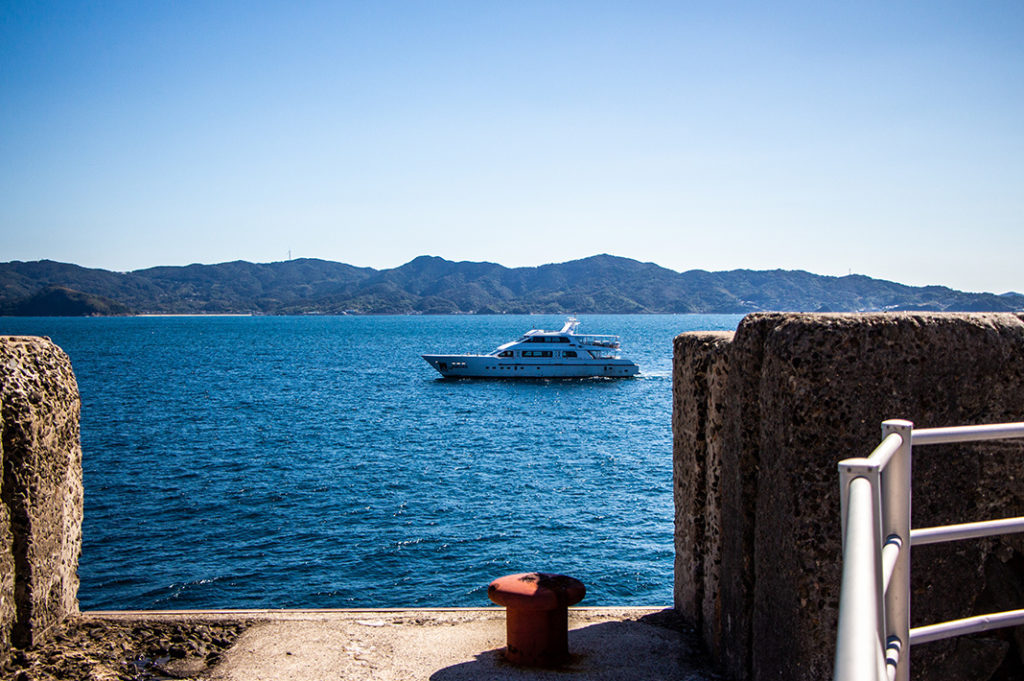
Gunkanjima cruise providers
There are only a handful of companies who are authorised to operate Gunkanjima cruises and tours. In the Motofunamachi area, not far from Nagasaki Station, you’ll find Gunkanjima Cruise Co. and Yamasa-Kaiun . Over at Tokiwa Terminal, near the Oura Church area, are the Seaman Gunkanjima Tour company and Gunkanjima Concierge —the latter of which I chose. Each of the providers offer morning and afternoon cruises, with tickets costing roughly 4,000 yen for adults across the board. Schedules and prices can be found on their respective websites where you can also book directly.
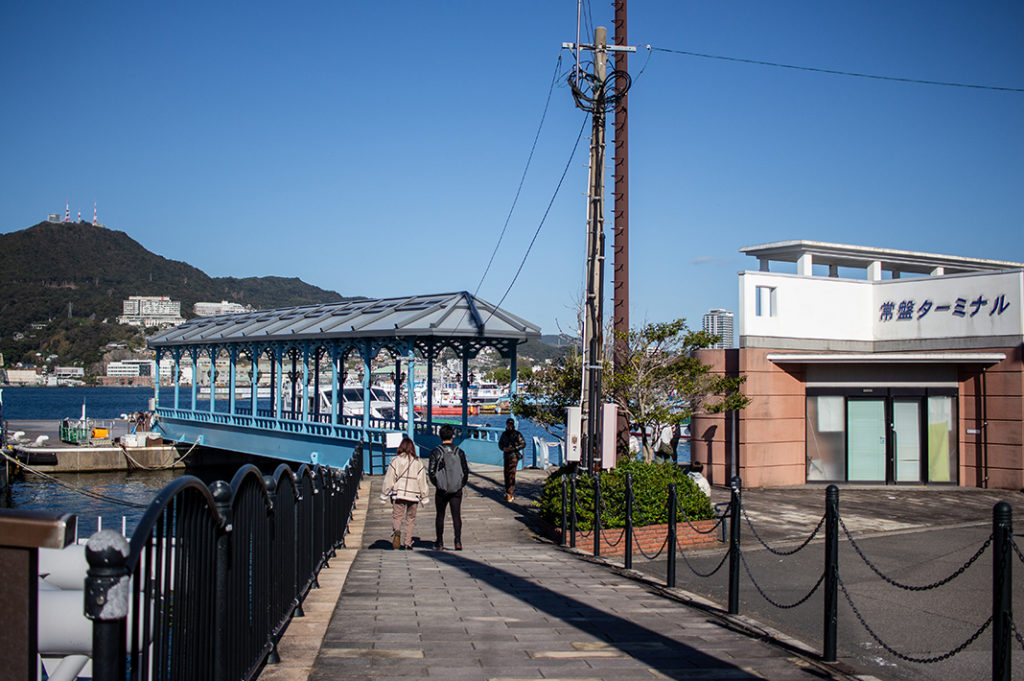
Gunkanjima Concierge
At Gunkanjima Concierge , the regular ticket costs 4,000 plus a 300 yen fee for accessing the island. I went with the next plan up, the ‘Priority’, which costs an extra 900 yen, and gave me half-priced entry to the Gunkanjima Digital Museum as well as priority boarding on the outbound trip. The museum contains three floors of digital displays, movies, images, models and even VR experiences to help visitors understand more about life on Hashima. It is also the check-in point for the cruise and is where you get your numbered sticker for boarding. I wanted to learn as much as possible about Hashima before visiting, so I went early to browse the exhibits with my discounted entry. I will cover this attraction in more detail in my next article. When it was time for the Gunkanjima cruise, I made my way a few blocks over to the Tokiwa Pier.
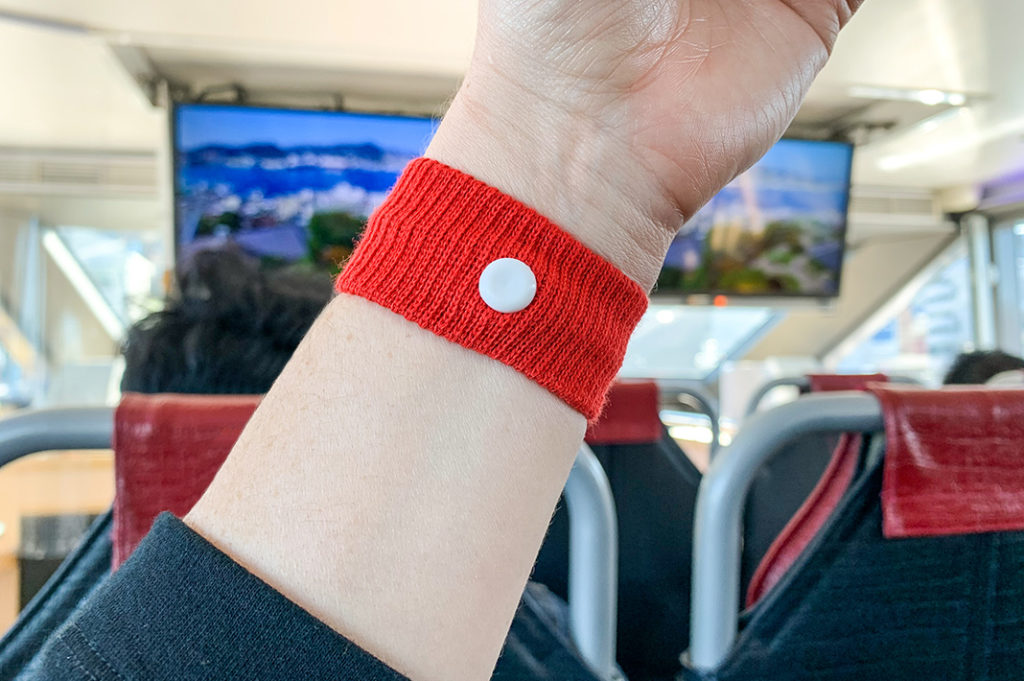
The cruise portion
I arrived to an excited crowd and a dismal forecast. On the day’s information board, the sea conditions were listed as simply a screaming emoji. Just as I had feared, rough seas were ahead. Perhaps seeing my ashen expression, a friendly staff member sidled up and suggested I head inside to purchase the anti-sea-sickness pressure bands; I’ve never spent ¥500 so quickly. By the time I’d gotten my bands in place and was given a folder full of information (in place of the usual English audio guide which was temporarily withheld due to social distancing measures), a long queue had formed beside the ship. This is when the priority boarding privileges came in handy, as I was ushered to the head of the line.
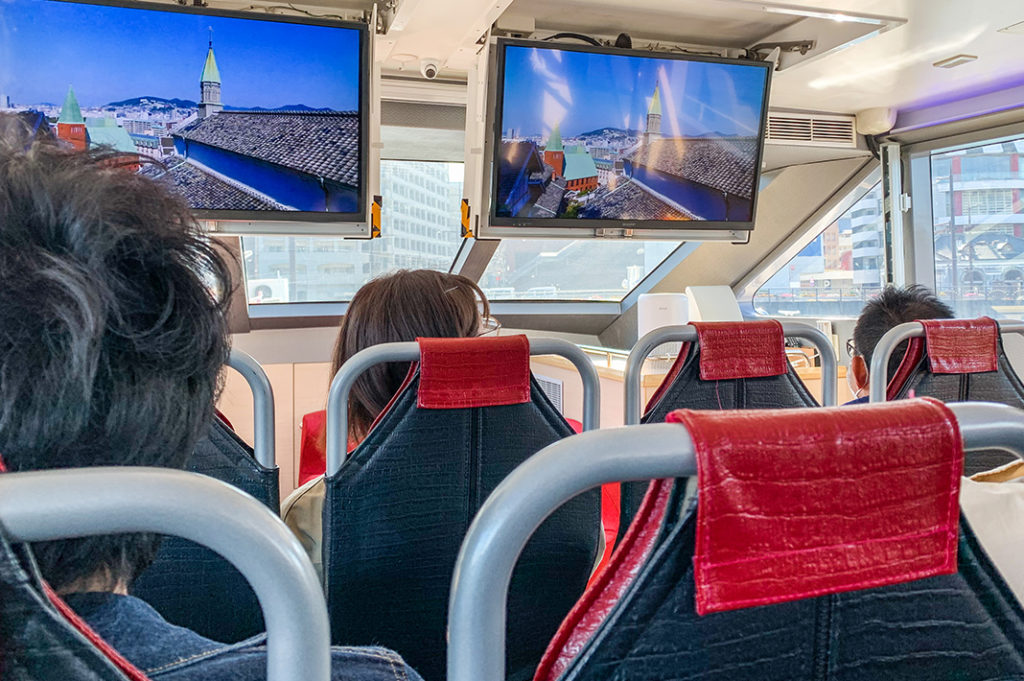
All aboard
The boat is a sit-where-you-like situation. However, the ‘Premium’ ticket (around 8,000 yen) holders had a special area upstairs, as well as VIP access to the front of the boat. I clocked the sick bags, took the boiled lollies from the staff and fastened my pressure bands as we commenced the choppy ride towards Hashima. The seats all faced the front where screens showed images and mid-century footage to accompany the guide’s presentation. He occasionally dipped into English for my sole benefit but the information folder was filled with interesting snippets.
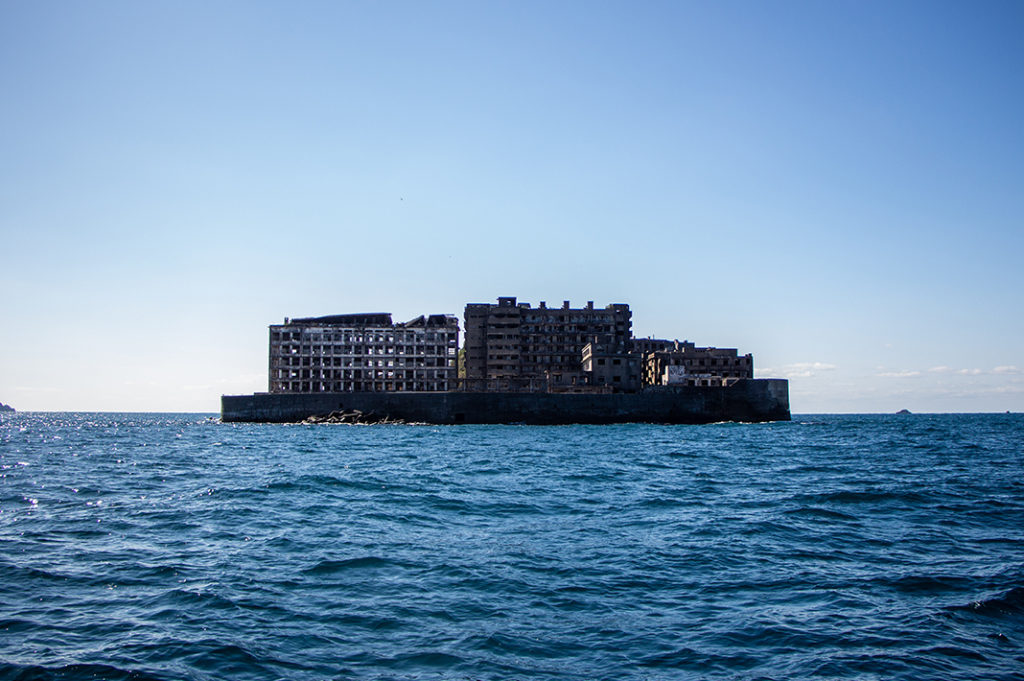
Once Gunkanjima was in sight, the Premium ticket holders went to the front of the ship for photos, while the rest of us went to the windows or out to the rear. The ‘three points of contact’ rule is king, here. It was rough . As we got closer, I could see the sky through the smashed out windows of the deserted high-rises, and the sea birds circling above.

Touring Hashima island
We disembarked and staff led us into the rubble. The roaring sea winds died down, silence descending over us. It’s far too dangerous to walk around the island unattended, so there are three designated viewing zones. Surrounded by concrete, rusted steel and smashed bricks, we made our way through as the guide spoke in Japanese about the history and function of certain buildings. Without the audio guide, I simply took in my eerie surroundings and photographed them.
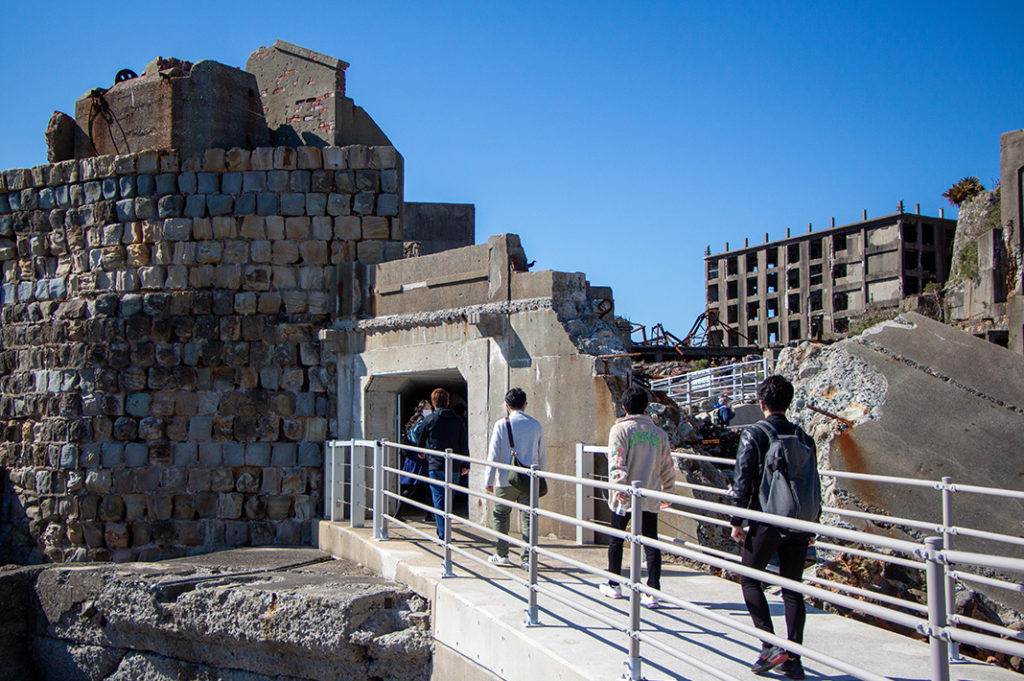
Hashima was home to so many people and many of the former residents have fond memories of their time here. The Digital Museum’s website has a written account from a former resident who returned to the island on a Gunkanjima cruise and said they wanted to scream. Those fond memories replaced by a dystopian warzone. Looking at the drab grey all around, I recalled what I’d read on the boat: that Gunkanjima was jokingly called ‘the island without green.’ At one time, rice paddies were set up on one of the rooftops to teach children about agriculture. Unfortunately, the building wasn’t waterproofed and the rice paddy leaked on the residents below. Oops!
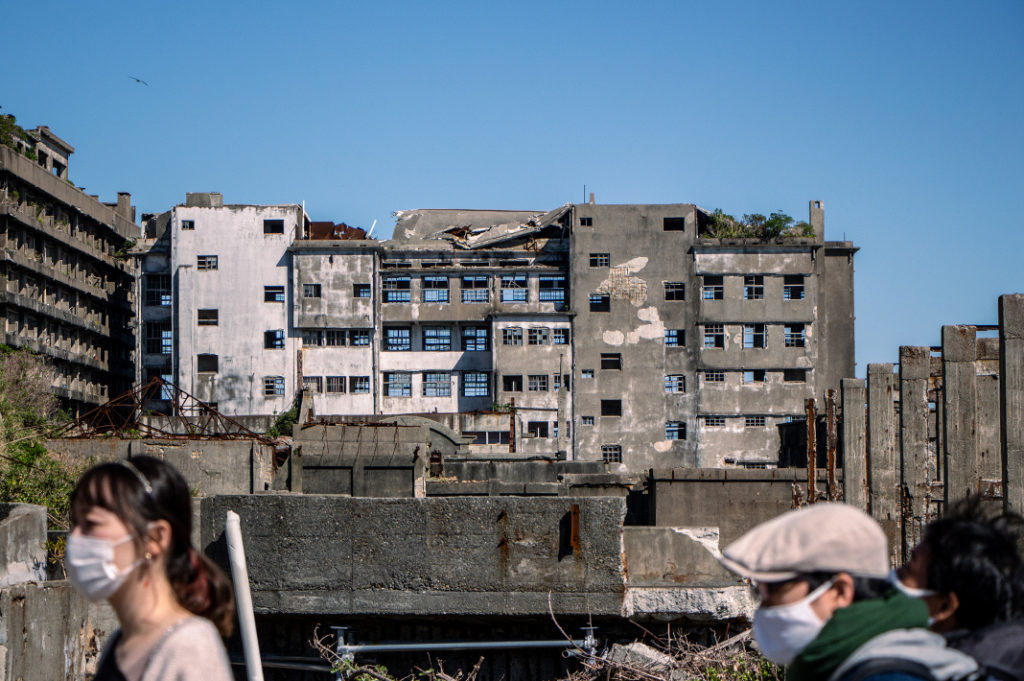
Of course, Hashima also has a sad history. It was, for a time, home to a number of POW labourers who were made to work in the mine. Perhaps this knowledge is what caused me to shiver when I saw the twisted remains of the mining equipment because it wasn’t that cold.
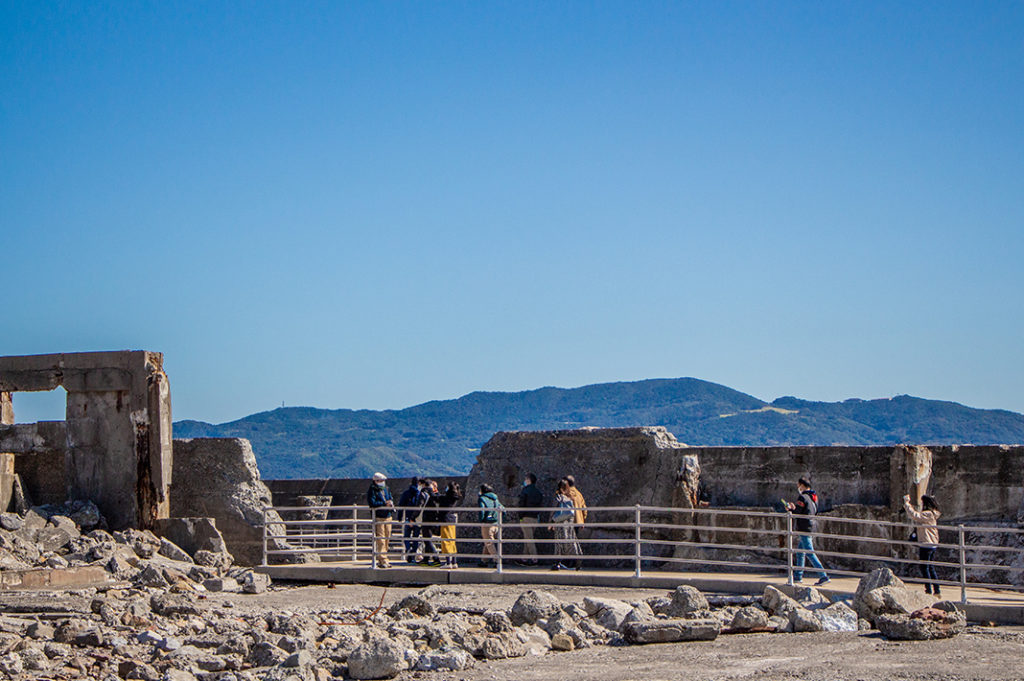
Heading back
The staff herded us back to the boat, as no doubt another tour company was coming our way. I checked to make sure my new favourite thing in the world, the pressure bands, were in place before climbing aboard. On the return journey, I read that Hashima is just one of over 500 abandoned islands in Nagasaki prefecture alone. In fact, Gunkanjima Concierge also offers tours of another island: Ikeshima. Unfortunately, it was closed due to typhoon damage but it’s earmarked for next time.
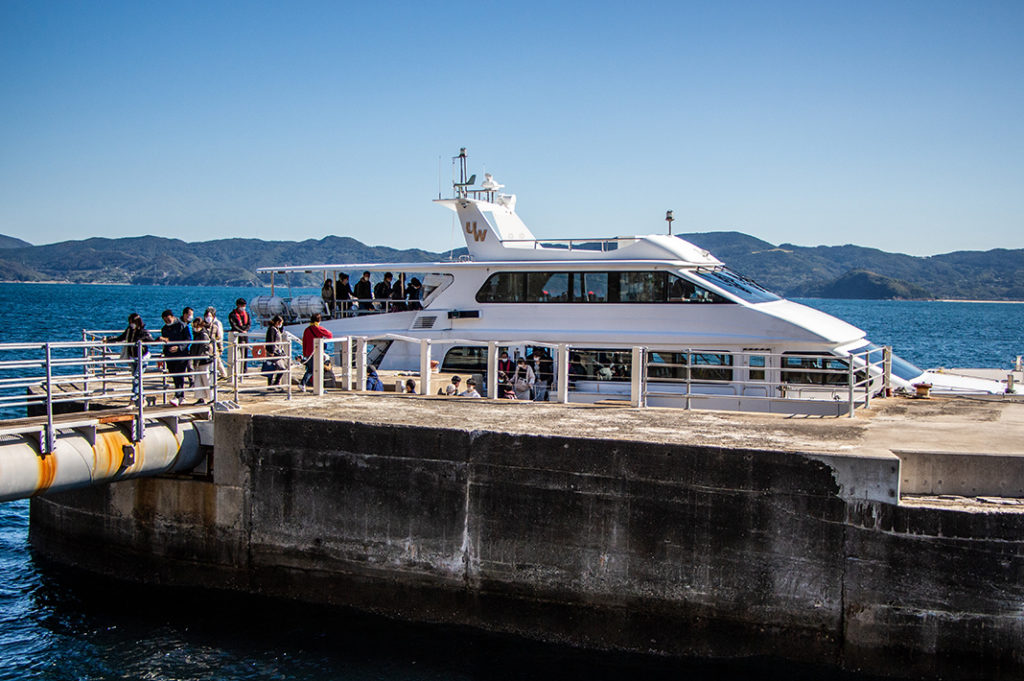
As we sailed back into Nagasaki Bay, our guide pointed out the Mitsubishi shipyard—previous owners of the Hashima mine and Gunkanjima island. It’s fair to say I’ll never look at one of their cars again without thinking of this day.
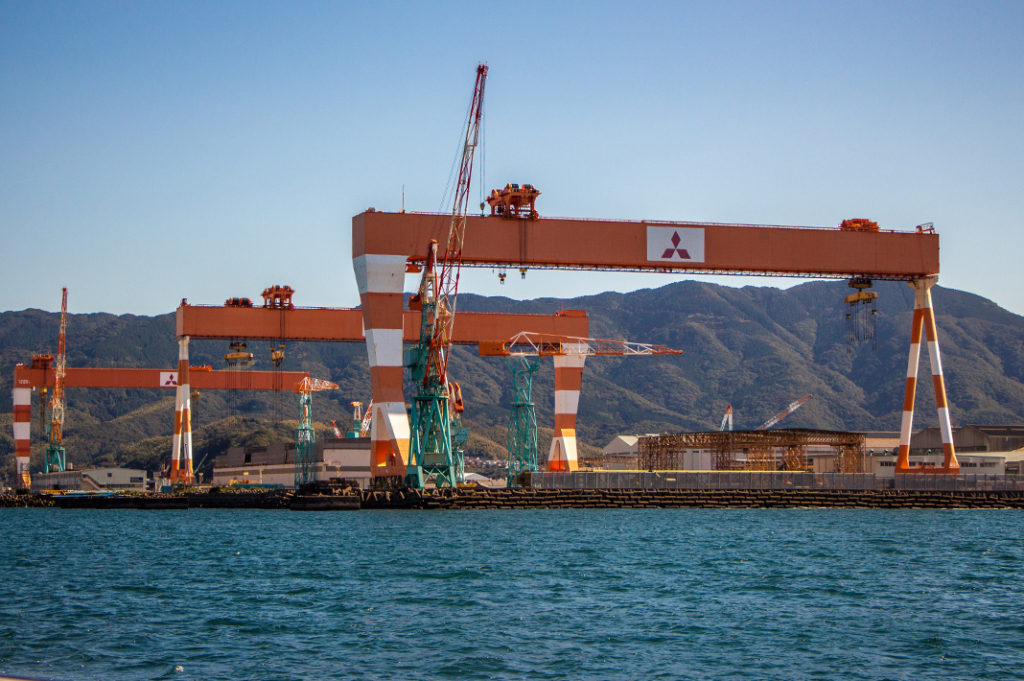
Visiting Hashima was a dream come true. As it is forever deteriorating, there’s no time like the present to visit. For those unable to visit due to poor weather conditions or a tight itinerary, you can always Google it. Amazingly, a person rigged with a 360º camera was sent in so we can experience the ruins using Google street-view. Alternatively, check out the 007 Skyfall movie which has a scene filmed on the island.
Post by Japan Journeys .
RELATED ARTICLES MORE FROM AUTHOR
Ine bay sightseeing boat: birds and boat houses, exploring tokyo’s biggest cave: nippara limestone caves, uga shrine: a power spot island on lake nojiri, most popular, refined kaiseki and stunning gardens at tofuya ukai, visiting the world’s tallest tower: tokyo skytree, a $500 sandwich at nakameguro’s wagyu mafia, late night eats at ebisu yokocho, kasuga taisha shrine: the 3,000 lantern shrine in nara deer park, japanese cosmetics: our favorites to shop for in japan, all rise for kikuya’s standing tempura in ebisu, a tuna extravaganza at maguro mart in nakano, oura church: a beacon for christians in nagasaki, sara udon: nagasaki’s other famous regional dish.
- International edition
- Australia edition
- Europe edition

Dreaming an Island review – an eerie tour of planet Earth’s depopulated future
This documentary about a small Japanese island, a once thriving mining outpost that now has only 100 residents, lightens its existential concerns with a focus on human connection
I n his second full-length documentary, Swiss director Andrea Pellerani gives us a guided tour of what a post-industrial, post-growth, or even an eerily post-human future might look like. We are on the south-western Japanese island of Ikeshima. Once a thriving mining outpost that was home to 8,000 people, since the facility’s closure in 2001 it has been reduced to just 100 mostly elderly holdouts. As the residents fish the grey sea off abandoned wharves, inspect pregnant cats and loiter around derelict lots, there is a sense they inhabit the set of a long-shuttered stage play, and are awaiting new lines.
Though it begins with long tracking shots of greenery choking empty apartment blocks, Dreaming an Island isn’t exactly ruin porn . Pellerani is more interested in the vestiges of human activity, and milks a distinct absurdity from the stalwart locals. One collects “fun” beach flotsam, there are guides waiting rather optimistically for an upswing in coal-mining tourism, while Ikeshima’s sole restaurateur hopes for a customer. “Is there anything interesting to see?” asks one who finally turns up. “In what sense interesting?” she replies.
The existential quotient spikes in the sections at the island’s school, where 11 teachers cater to just two pupils. A tutor has one of them running sprint drills out on the training field, preparing for some hypothetical athletics meet.
No doubt because it’s inherent to the subject matter, Ikeshima’s stasis makes it tricky for Pellerani to find dramatic through-lines; filling even 76 minutes feels like a struggle. Ikeshima is a canary in the coalmine for Japan, which, with its plummeting birth rate and stagnant economy , is often itself talked up as a canary for the rest of the developed world. But if this wan afterlife really is our future, then Pellerani also emphasises a dutiful bravery in affirming old ways and believing they can be renewed. In a peppy coda, children and teachers arrive at an old people’s home to present them with artwork, play darts and sing old-time ditties. Mines can be exhausted but human connection endures in this fond not-quite-swansong.
- Documentary films
- Asia Pacific
Comments (…)
Most viewed.

8 Must-visit Japanese Ghost Towns
Want a spine chilling experience in Japan? Here are Japanese ghost towns that will definitely give you the creeps! Check it out!
Would you call yourself a “daredevil”? Do you love doing things that give you that adrenaline rush?
Well, we are not talking about skydiving or bungee jumping here, we are talking about doing things like exploring places and not just any places, but ghost towns! Sounds like fun (or maybe not) right?
Japanese ghost towns are those towns that have been abandoned over the years because they were known to be inhabited by ghosts or yokai, as the Japanese call it. Some of these towns were left abandoned due to various other reasons as well like nuclear disasters, mining disasters, mine closures and incomplete projects.
- Related: Haunted Spots in Japan You Have To visit
What’s the hype about these ghost towns, you may ask. Well, in the present day, a lot of researchers and YouTubers have started visiting these ghost towns in order to explore them, since these towns are now completely dilapidated. Some of these towns have also become tourist sites that visitors throng to see every year.
Most Haunted Japanese Ghost Towns
Gunkanjima: the hashima island.
Location: Nagasaki Prefecture

Most often called as Gunkanjima (meaning warship) or nicknamed as the “Battleship Island”, because of its shape, this island has been abandoned since the 20th of April 1974.
It is located close to the city of Nagasaki and has been open for visitors to view certain portions of the island since 2009, after 35 years of complete abandonment! This island has also been a famous site for many documentaries, feature films and docu-series as well.
Weathering #photography #artphotography #gunkanjima #軍艦島 #Nagasaki #Japan #廃墟 #ruin #olympus #PenF #PenFlens #ファインダー越しの私の世界 #写真好きな人と繋がりたい pic.twitter.com/Ra1xv2LPzt — Macky/ME-SCAPE (@MEscape_photo) June 10, 2019
The Hashima Island was largely developed due to its undersea coal mines that were discovered in the late 1800s and was fully operational with its all- time peak population of over 5,000 people, in 1959.
The island was bought by the Mitsubishi group in 1890 and they began extracting coal thereafter. The island had its own apartment blocks, schools for the children, community center and town hall, swimming pools and shops for the miners and their families.
It is also known that during the time of the Second World War, conscripted Korean civilians and prisoners from China were also forced to work in the mines under harsh conditions and this caused the death of many of the miners due to malnourishment, exhaustion and mining accidents.
Finally got to explore the #ruins of #gunkanjima in it’s entirety. Twelve hours on the island, documenting the decay, dilapidation and disrepair of a once bustling island community. Was shooting there with @IciJapon . Full set of images over on my Instagram→ #haikyo #廃墟 #軍艦島 pic.twitter.com/INvnQXqXCf — Ben B (@benbeechphoto) March 23, 2022
Later, in 1974, the island’s coal reserves depleted and the mine closed, clearing out all its residents. The island was then left abandoned ever since, until 2009, 35 years later, when it opened out for tourism purposes.
Shiraiwa Village
An immense feeling of sorrow and emptiness envelops the remote Shiraiwa Village in Saitama Prefecture, Japan. It’s a place filled with a stillness that pervades most of the area’s decaying structures, long abandoned but seemingly never forgotten.
One of the oldest inhabited areas in Japan, Shiraiwa Village is an eerie silent witness of the past, a testament to the decline of development in the region.
After the mining area was closed in the 70s and 80s, much of the town was slowly abandoned by its inhabitants, never to be repopulated.
The small community was left to the elements, allowing nature to slowly reclaim what was once theirs.
The remnants of the small settlement came to embody a unique kind of ghost town, one to be appreciated more for its desolate beauty than its former vibrancy.
The rows of abandoned houses, the silent dirt paths, the eerie silence that hangs in the air are images that come to mind when hearing of Shiraiwa Village.
Visitors to the area often remark on its surreal atmosphere, as if its lingering inhabitants had just stepped out of the forgotten houses. There is a melancholic energy that permeates the entire area, far removed from the hustle and bustle of modern Japan.
For many, it is a reminder of the fragility of human development, and the transient nature of life.
Ashiodozan Ghost Town
Ashiodozan was once a thriving copper-mining town in the mountains north-east of Tokyo, but nowadays it stands as an abandoned, eerie ghost town.
Here lies the evidence of the extreme environmental damage caused by industrialization and the reckless exploitation of the area’s physical resources during the Tokugawa Shogunate’s reign.
The Tokugawa Shogunate commandeered the area and ramped up mining operations, leading to Ashio producing 40-percent of the nation’s copper, an enormous number at the time.
This led to the population of the village increasing to 39,000, even though all of it was due to the small number of miners and workers.
However, after the Second World War, production slowed down and all mines were eventually shut down by 1973.
The now-closed copper-mining town and its surrounding areas were left neglected, forgotten, and plagued with the effects of extreme environmental damage and sulfurous acid gas from smelters, slowly and surely poisoning the nearby mountains with its fumes.
Today, Ashiodozan stands as a haunting reminder of the consequences of human greed, recklessness, and carelessness.
Much of the area still shows evidence of almost 40 years of abject neglect. Brown stains on trees, buildings, and ground indicate the corrosion of metals, as well as places of danger when people come too close.
The semi-abandoned village lies in stark contrast to the beautiful mountain views, which have been blinded by pollution for years.
The Nagatani Village
Location: Fukui Prefecture
Located in the central part of Japan’s Fukui prefecture is the village of Nagatani, which has been left abandoned for over 20 years now.
In the year 1966, the residents were asked to leave the town because there were plans of building a dam near the Nagatani village.
The village was inhabited by around 70 people at that time and the villagers fought against this proposition, but unfortunately it was all in vain.
Eventually, one by one the people of the village had to leave Nagatani because the project was going to start sooner.
But some of the people were completely against the plan and refused to leave Nagatani. Finally, by the 1990’s, all the villagers had evacuated Nagatani, because their efforts to stop this project were to no avail.
Some years later, it came to be known that the project of building the dam near Nagatani had been called off and thereafter, the villagers never returned to the place, leaving this village uninhabited ever since.
Today, there are some people who visit this ghost town of Nagatani to explore the place and see the ruins of the villagers’ dilapidated houses, shrines and temples that have been taken over by nature.
The Fukushima Ghost Towns
Location: Okuma Town, Fukushima Prefecture
The Fukushima ghost towns came into existence and became very popular because of the Fukushima nuclear disaster that took place in the year 2011, at the Fukushima Daiichi Nuclear Power Plant.
Ten years may seem like a lifetime, but the nuclear accident that happened in Fukushima exactly a decade ago continues to affect Japan. ⁰ Today, some 35,000 survivors are still living as evacuees, forced from their homes due to safety concerns. #FukushimaNuclearDisaster pic.twitter.com/N2JkvhyHzv — Greenpeace International (@Greenpeace) March 11, 2021
It is known that the cause of this disaster was because of the Tohoku earthquake and a resulting tsunami that occurred in close proximity to the power plant that caused it to get damaged. This disaster then became the most severe nuclear disaster ever, after the Chernobyl disaster that had occurred in 1986.
11th March. This is the 11th year of Fukushima nuclear disaster + Tohoku earthquake and Tsunami. Remembering that day Remember, it is still there. #11thMarch #fukushima #3月11日 #tohokuearthquake #tohokutsunami #Fukushimanucleardisaster #東日本大震災 #津波 #福島第一原発事故 pic.twitter.com/FOztwhqvng — Rie Takeda (@neojaponism) March 10, 2022
The reason for the nuclear disaster was because the earthquake triggered a huge tsunami, which created waves of over 46 feet in height that flooded the power plant. This resulted in three nuclear meltdowns, the release of radioactive contamination and three hydrogen explosions in the plant.
This caused severe radiation to be released into the atmosphere. Due to this disaster, the town had to be immediately evacuated of all the people who lived within the radius of 20 kilometers around the plant.
So around a 100,000 residents were evacuated during this large-scale evacuation called by the government.
Ever since then, the Fukushima towns have been called ghost towns as the people never returned.
As of today, even though the government promises the people that the towns are completely safe for them to stay, along with their families and the government urges the people to return, they are reluctant as they still consider the fact that there may be repercussions of the then nuclear disaster.
The Nichitsu Mining Town
Location: Saitama Prefecture
The Nichitsu town is located in the Saitama prefecture was very famous for the mining of tin. It is very often visited by visitors as it is no secret spot and is open to the public ever since it was deserted.
The town got its name because of the mining company that owned the village – Nichitsu. This village was where the tin mining took place and the labourers also resided in the same village because the main cities were too far away for them to commute on a daily basis. Over the years, the number of miners increased and the residents of the Nichitsu town went up to over 3, 000 people.
The mining town soon grew in size and also had their own schools for the children of the miners to study in, a cinema, for some entertainment, hospitals and also a post office. The labourers and their families were put up in apartments, while the bosses had their own houses.
Later, around the 1980s, it came to be known that the mining town slowly started to lose its residents and eventually the town had been abandoned for reasons unknown to the public. But speculations state that it could have been because the mining resources eventually depleted.
Currently, a lot of people still go to explore the mining area which can be accessed by crossing a dangerous bridge. While a certain part of the Nichitsu town is completely abandoned, it is known that some of the Nichitsu troops still guard the mining town.
The Ikeshima Coal Mine Town
The Ikeshima coal mining town is an island that became famous when it was bought by Mitsui, a famous mining company, in order to mine coal from a huge undersea coal reserve, which began in the year 1959. Over 8000 people including men, women and children were moved to the island, as the men were working as labourers to mine the coal.
The mining remained in an active state until 2001, until the labour costs began to rise, thus forcing the closure of the mine (while there is still coal that remains in the mine till today). Eventually, the labourers and their families left the island.
Today, this partly abandoned mining town now has only around 200 residents, those who chose to continue to live on the island. It is now thrown open to the public as it is a popular tourist spot for those who visit Nagasaki.
They get to have a tour around the island and the tourists are also taken into the mining tunnel and are allowed into the dilapidated apartments to view the ruins. There is still a functional school that has just 6 children who study there!
Also, the islanders offer a spot for tourists to spend a night on the Ikeshima Island, but unfortunately there is only one place that offers visitors an overnight stay (but with no food provided).
The Mukainokura Village
Location: Shiga Prefecture
The village of Mukainokura is well-known to be one of the most famous ghost towns in Japan and is very easily accessible both by train and by car. It is located in the Shiga prefecture on the top of a steep hill.
Mukainokura was known to be the home of around 95 people back in the 1880s, with just around 20 houses. The villagers used to live off agriculture and the production of briquettes of charcoal made from sawdust.
Over the years, the need for charcoal reduced as gas, oil and electricity replaced its use and this lead to the inhabitants of the village losing their jobs.
So, due to lack of work and money for their daily living, the people soon started moving out into the plains, to live in bigger cities for work purposes. Thereafter, from 52 inhabitants in the 1960s, the residents of the village decreased to zero in 1985 and the village was left permanently abandoned ever since then.
Apart from the loss of their jobs, other speculations state that it was because the village’s steep location was not favourable for daily travel and commute for the villagers to work elsewhere when they had to begin to work in the plains and thereby was left abandoned.
The final takeaway
If you are a lover of history and are someone who simply likes reading about spooky historical stuff like this or if you are one of those people who love to explore such places, then these 6 ghost towns in Japan are some of the spookiest places you could ever visit and they are so eerie that they will for sure give you the creeps! So go ahead and get exploring!
How Many Islands Makeup Japan? | What Are The Main Islands Of Japan?
Are you wondering how many islands makeup Japan? Well, Japan is made ...

Is Tsushima Island A Real Place? Facts & Fictions
If you’ve played Ghost of Tsushima, you’re probably wondering – ‘is Tsushima ...
- Tours & Experiences
- Tailor-made Trips
- Bahasa Indonesia
We are happy to see you again!
Continue with
Or use email.
No Account? Create one
Create account
Already have an account? Sign in
Quickly Sign up with
I agree to Japan Travel's Terms of Service and Privacy Policy . Terms of--> and acknowledge that Japan Travel's Privacy--> applies to me.-->
Email reset password link
Please check your inbox and click the link we will send to you.
Ieshima Islands: Welcome Home
Island group off Hyogo's coast in the Seto Inland Sea

“Ieshima” means “Home Island.” After waiting out a storm in the safety of Ieshima’s harbors around 600 BCE, Japan’s legendary first Emperor Jimmu described the islands as being, “So quiet it feels like home.”
The Ieshima Islands are a group of 44 small islands in the Seto Inland Sea. They are a part of the Setonaikai National Park and located a short 18 kilometers south of Himeji in Hyogo Prefecture. In addition to their well-protected harbors, the island are famous for the quality of the fish found in their waters, the stones from their quarries—used in the construction of Osaka Castle in the 16th century—and for their serene, quiet pace of life.
Of the 44 islands that make up the Ieshima Island group, only four are inhabited.
Nishijima and Tangajima, the largest and 3rd largest islands in the group, have been stone quarries for over 400 years. Today, they’re more well-known for their white sand beaches and clear blue water.
Bozejima, the smallest island, and Ieshima are home to the thriving fishing ports of Naza, and Miya and Maura. Fresh seafood is available all year long. Spanish and chub mackerel, Boze sea bream, black rockfish, conger eel, mantis shrimp, and so much more are fished and sold fresh everyday. Sashimi fresh off the boat can be had at numerous stores and restaurants on Bozejima and Ieshima. The most prized catch of all are Ieshima’s blue swimming crabs (“watarigani” in Japanese) and Bozejima’s mackerel (“saba”) that come into season in the autumn and winter. More intricate “kaiseki” multi-course meals, featuring a variety of local fish, are also available.
With fishing boats lining Ieshima’s docks, and rustic homes rising side-by-side up the slopes fronting the harbor, one could be forgiven for thinking they’d come to a Grecian isle in the Mediterranean.
Don’t Miss
44 island cruise.
With just 4 of the 44 Ieshima Islands being inhabited, the only way to experience the other 40 islands is by boat. Two hour island cruises, called Yon-ju-yon Shiawase no Shima, depart twice a day from Manoura or Miyako ports on Ieshima at 10am and 1pm. Cruises are ¥5,300/person and take visitors on a tour of the Ieshima Islands, with a short break at Bozejima before returning. While at sea, only the green trees of the islands break the blue line separating sea from sky.
Tatenohama and Aoinohama Beaches on Tangajima, and the Hyogo Prefectural Nature Experience Center on Nishijima offer visitors the chance to swim and play on the sandy beaches and calm sparkling blue water of the Seto Inland Sea.
Bentenjima is a small and scenic shrine on a tiny island dedicated to the dragon god of the sea, and is connected to Bozejima by an arched bridge. Legend states that a fisherman angered the god by capturing the enormous fish the god of the ocean was using to conduct his business on earth. The shrine is said to have been created by a tornado after the fisherman’s daughter sacrificed herself to the ocean to appease the god’s wrath.
Dongamessan
Dongamessan is a giant rock in the shape of a turtle. Legend has it that a giant turtle waited in this spot for its owner to return until it turned to stone. A wish made by visitors who pat the turtle’s head 100 times is said to be granted.
Tenjin Festival
Every year on the 24th and 25th of July, Ieshima Shrine hosts the Tenjin Festival (“Tenjin-matsuri") to pray for safety on the oceans, and for abundant harvests of seafood and rice. The festival features dancers wearing shishimai dog-lion headdresses performing their traditional dances on a special festival boat in the harbor. It’s the only place in Japan to practice a shishimai dance on water.
Experience Ieshima
Exploring the backstreets.
With flat ground on Ieshima being limited, houses, buildings and roads were built wherever they could, leading to a beautifully elaborate maze of narrow backstreets that have seen little in the way of modernization. Wells, springs, pumps and other historic items from centuries past can be found on a stroll through the historic town. Join a friendly local guide and experience a slower and simpler life.
Fishing Experiences
Seaside fishing - The Ieshima Fishing Park “Seayou” provides visitors with fishing poles and bait. Whether they catch something or not, visitors will be gifted with fresh fish from Ieshima as part of the experience.
Seine fishing - Join local fisherman on a seine fishing or trawling experience. Drop a net into the water, drag it along the bottom and then pull it up by hand. Anything you catch will be prepared for you once you return to shore.
Canoeing and Kayaking
Paddle your way around Ieshima on a canoe or kayak! The Himeji City Ieshima B & G Marine Center provides rentals of stable and easy to use canoes and kayaks, as well as instruction in proper boating technique, allowing visitors to explore Ieshima from the water at their own pace. Other marine sports experiences such as boating and windsurfing are also available. The center’s facilities also include a heated swimming pool, gymnasium, tennis courts, and more.
Electric bicycle
With the largest of the Ieshima Islands being less than 7 square kilometers in size, bicycles are a great way to get around and see all the islands have to offer. Rentals of electrically assisted bicycles are available, and knowledgeable and friendly guides can make your ride a joyous and memorable experience. Bicycle rentals on Ieshima are ¥1,000/1hr, ¥1,200/3hrs, and ¥1,500/5hrs for electrically assisted bicycles through the Ieshima Tourism Association, regular bicycle rentals, from Takafuku Liner, are ¥600/day. On Bozejima, an all-day bike rental (7:40am-5pm) is just ¥1,500.
Ieshima Shrine Stroll
Ieshima Shrine has a history dating back over 2,000 years and is dedicated to the seafarers and safety on the oceans. It sits amid a sacred primeval forest that has been untouched by man since before the shrine’s creation. Strolling its paths and grounds and experiencing the silence of the trees and the waves is said to be a meditative and rejuvenating experience.
Firefly Viewing
For about one month from the middle of May to the middle of June fireflies light up the night in the bamboo groves of Ieshima Shrine, and 10 other locations around Ieshima, with their beautiful yellow-green glows.
Book your Ieshima experience
- Share on Facebook
- Share on Twitter
- Copy link to share
By Bryan Baier
Community writer
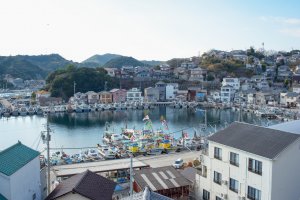
Information
Map ( Directions )
Book your trip
Find a nearby hotel, explore nearby.

Totoro Restaurant in Himeji
By José Manuel Zardain

Himeji Castle and Engyoji Temple
By Rey Waters

Himeji Otemae Street Illumination

Watami Japanese Restaurant
By Bonson Lam
Top Articles
- Recommended

Kurobe Unazuki Canyon Route to Link with Tateyama Kurobe Alpine Route

Tokyo One of the World's Most Walkable Cities

Mount Omuro

2024 Grand Sumo Tournaments

Guide to Golden Week

Sapporo Beer Opens New Brewery in Tokyo’s Ebisu

Haneda Airport Ranked World's Cleanest

Tokyo Takes 2nd Place on Top Coffee Cities List

Valley of Witches: a New Ghibli Park Attraction

Guide to Bringing Medicines Into Japan

Your Name: Real-Life Locations in Tokyo

Hachiko Statue in Shibuya

Iwatayama Monkey Park

Shibuya Crossing

Daikoku Car Meet

Kanamara Penis Festival

Guide to Suica Cards

Japanese Urban Legends

Guide to PASMO Cards
More from this category.

Suo Oshima "Japanese Hawaii" Sports..

Ginowan Tropical Beach & Park
By Chris Barnes

Tashirojima Cat Island
By Brian Takahashi

Kotohiki Beach
By Robert Kodama
Join the discussion
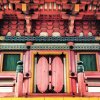
Let us know how we can help.
Help us improve JapanTravel.com
We welcome any suggestions regarding this content. Your feedback is confidential and will be used to help improve this page.
Suggest an edit
https://en.japantravel.com/hyogo/ieshima-islands-welcome-home/53196
Thank you for your support!
Your feedback has been sent.
- Media & Industry
- Meetings & Events
- Select Language 简体中文 繁體中文(香港) 繁體中文(臺灣) India (English) Bahasa Indonesia 한국어 ภาษาไทย Tiếng Việt Singapore (English) Philippines (English) Malaysia (English) Australia/New Zealand (English) Français Deutsch Italiano Español United Kingdom (English) Nordic countries(English) Canada (English) Canada (Français) United States (English) Mexico (español) Português العربية Japan(日本語) Global (English)
- India (English)
- Bahasa Indonesia
- Singapore (English)
- Philippines (English)
- Malaysia (English)
- Australia/New Zealand (English)
- United Kingdom (English)
- Nordic countries(English)
- Canada (English)
- Canada (Français)
- United States (English)
- Mexico (español)
- Global (English)
- Fujiyoshida
- Shimonoseki
- Ishigaki Island
- Miyako Island
- Kerama Island
- Tokyo Island
- Koka & Shigaraki
- Hida Takayama
- Ginza, Nihonbashi
- Beppu & Yufuin (Onsen)
- Ginzan Onsen
- Nagasaki Islands

- Kumano Kodo
- Shikoku Karst
- Amami Oshima
- Hachimantai
- Omihachiman
- Aizuwakamatsu

- Diving in Japan
- Skiing in Japan
- Seasonal Flowers in Japan
- Sustainable Outdoors
- Off the Beaten Track in Japan
- Scenic Spots
- World Heritage
- Home Stays & Farm Stays

- Japanese Gardens
- Japanese Crafts
- Temple Stays
- Heritage Stays
- Festivals and Events
- Theater in Japan
- Japanese Tea Ceremony
- Cultural Experiences in Japan
- Culture in Japan

- Local Cuisine Eastern Japan
- Local Cuisine Western Japan
- Local Street Food
- Japan's Local Ekiben
- Japanese Whisky
- Vegetarian and Vegan Guide
- Sushi in Japan Guide
- Japanese Sake Breweries

- Art Museums
- Architecture
- Performing Arts
- Art Festivals
- Japanese Anime and Comics
- Japanese Ceramics
- Local Crafts

- Scenic Night Views
- Natural Wonders
- Theme Parks
- Samurai & Ninja
- Iconic Architecture

- Wellness Travel in Japan
- Japanese Ryokan Guide
- A Guide to Stargazing in Japan
- Relaxation in Japan
- Forest Bathing (Shinrin-yoku)

- Experiences in Japan
- Enjoy my Japan
- National Parks
- Japan's Local Treasures
- Japan Heritage
- Snow Like No Other
- Wonder Around Japan

- Visa Information
- Getting to Japan
- Airport Access
- COVID-19: Practical Information for Traveling to Japan
- Anime Tourism
- Countryside Stays
- Accessible Tourism
- Hokkaido Great Outdoors
- Scenic World Heritage in Tohoku
- Shikoku’s Nature and Traditions
- Southern Kyushu by Rail

- Traveling by Rail
- How to Travel by Train and Bus
- JR Rail Passes
- Scenic Railways
- Renting a Car
- Sustainable Travel in Japan
- Travel Brochures
- Useful Apps
- Online Reservation Sites
- Eco-friendly Accommodation
- Luxury Accommodations
- Traveling With a Disability
- Hands-free Travel
- How to Book a Certified Tour Guide
- Volunteer Guides
- Tourist Information Center

- Japanese Manners
- Spring in Japan
- Summer in Japan
- Autumn in Japan
- Winter in Japan
- Cherry Blossom Forecast
- Autumn Leaves Forecast

- Japan Visitor Hotline
- Travel Insurance in Japan
- Japan Safe Travel Information
- Accessibility in Japan
- Vegetarian Guide
- Muslim Travelers
- Safety Tips

- JAPAN Monthly Web Magazine
- Arts & Cultures
- Nature & Outdoor
- Festivals & Events
- Insider Blog
- Things to do
- Local Guides
- Food & drink
- Traditional
- Hokuriku Shinetsu

My Favorites
${v.desc | trunc(25)}
Planning a Trip to Japan?
Share your travel photos with us by hashtagging your images with #visitjapanjp
- Ieshima Island
Ieshima Island 家島
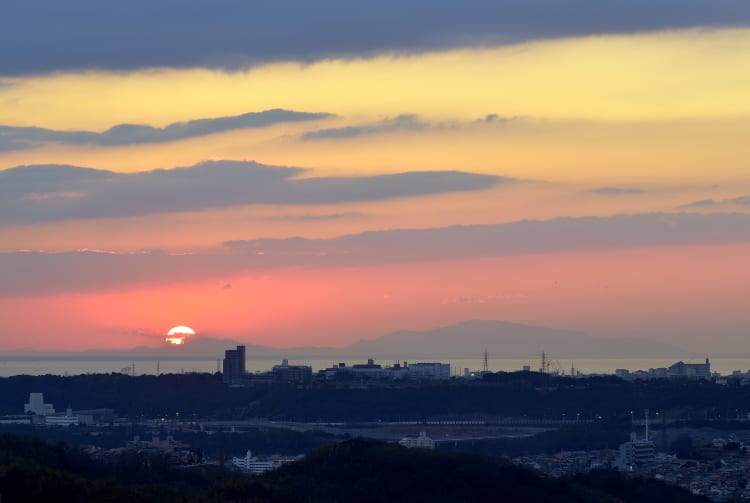
Himeji-shi, Hyogo-ken
- View on Google Maps
- Get Transit Info
Scenic islands located in the Seto Inland Sea
Ieshima is a collection of 44 islands just off the coast of Himeji City in the Seto Inland Sea. Just four of the islands are large enough to be inhabited; Ieshima Island is the largest of these. The name Ieshima is used to refer to the island on its own as well as the entire chain.
Quick Facts
One of the islands, Nishijima, hosts the annual "Open Water Swim Competition"
Approximately 6,000 residents live mainly on Ieshima and Bozejima
How to Get There
The islands are connected by ferry. Ieshima Island can be reached by an approximately 30-minute ferry ride from Himeji Port. It takes a similar amount of time to reach Bozejima, the island with the second-largest population.
About Ieshima island
On Ieshima Island sits Ieshima-jinja, a shrine dedicated to seafarers with a history of more than 1,000 years. The shrine's annual Ieshima Tenjin Festival takes place on July 24 and 25 and features a traditional performance in which dancers wear headdresses in the image of the fictional shishi lion and pray for safety on the seas and an abundant harvest.
The Ieshima Jukkei is a collection of 10 scenic spots in the islands, including the site of old castle ruins on Ieshima and other Edo-period remains.
Most inns are located on Ieshima and Bozejima.
* The information on this page may be subject to change due to COVID-19.
Recommended for You

Please Choose Your Language
Browse the JNTO site in one of multiple languages
NYC 5 Boro Bike Tour 2024: Everything you need to know about parking on Staten Island
- Updated: Apr. 27, 2024, 6:18 p.m. |
- Published: Apr. 27, 2024, 1:00 p.m.

More than 32,000 participants in the NYC Five Boro Bike Tour will descend upon New York City on May 5, and they’ll finish their 40-mile journey in Fort Wadsworth. (Staten Island Advance/Derek Alvez).
- Ann Marie Barron | [email protected]
STATEN ISLAND, N.Y. — More than 32,000 participants in the TD NYC Five Boro Bike Tour will descend upon New York City on Sunday, May 5, and they’ll finish their 40-mile journey in Fort Wadsworth.
The event is billed as the largest charity bike ride in the world, with participants riding through all five boroughs of the city.
If you purchase a product or register for an account through a link on our site, we may receive compensation. By using this site, you consent to our User Agreement and agree that your clicks, interactions, and personal information may be collected, recorded, and/or stored by us and social media and other third-party partners in accordance with our Privacy Policy.
Green Energy
Electrek green energy brief.
- Offshore wind power
Watch the world’s first artificial energy island being built [video]
The first of 23 caissons for Princess Elisabeth Island, the world’s first artificial energy island, is nearly complete.
Princess Elisabeth Island will be an electricity grid at sea that will connect offshore wind farms to the Belgian mainland and also serve as a hub for future interconnectors with the UK and Denmark. Belgian electricity transmission system operator Elia is the project’s developer.
The 20,000-ton caissons, which will form the energy island’s outer walls, are being built at Jan De Nul Group and DEME’s construction site in Vlissingen, the Netherlands. It takes around three months to build one caisson. The production process is split into five 20-day stages. The caissons are moved between the different work sites using “runners,” which takes about six hours.
When the caissons are ready, a semi-submersible vessel will transport them further down the harbor, where they’ll be temporarily stored in the water. They’ll then be moved to their final location in the North Sea this summer, weather allowing, said maritime infrastructure company Jan de Nul .
You can watch a time-lapse video of Princess Elisabeth Island’s first caisson being built here:
Princess Elisabeth Island is part of the larger Princess Elisabeth Zone, a future 3.5 gigawatt (GW) offshore wind farm in the North Sea, around 45 km (28 miles) off the Belgian coast. The world’s first artificial energy island will receive power from the wind turbines via undersea cables, and it will then be converted to high-voltage electricity and distributed to the Belgian mainland and other European countries. The energy island will combine both direct current (HVDC) and alternating current (HVAC).
The energy island will be finished in late 2026 when the electrical equipment will start to be installed. Princess Elisabeth Island is expected to be fully connected to all wind farms and the mainland by 2030.
Read more: 2023 was a record year for wind power growth – in numbers
If you live in an area that has frequent natural disaster events, and are interested in making your home more resilient to power outages, consider going solar and adding a battery storage system. To make sure you find a trusted, reliable solar installer near you that offers competitive pricing, check out EnergySage , a free service that makes it easy for you to go solar. They have hundreds of pre-vetted solar installers competing for your business, ensuring you get high quality solutions and save 20-30% compared to going it alone. Plus, it’s free to use and you won’t get sales calls until you select an installer and share your phone number with them.
Your personalized solar quotes are easy to compare online and you’ll get access to unbiased Energy Advisers to help you every step of the way. Get started here . –ad*
FTC: We use income earning auto affiliate links. More.

Electrek Green Energy Brief: A daily technical, …
Michelle Lewis is a writer and editor on Electrek and an editor on DroneDJ, 9to5Mac, and 9to5Google. She lives in White River Junction, Vermont. She has previously worked for Fast Company, the Guardian, News Deeply, Time, and others. Message Michelle on Twitter or at [email protected]. Check out her personal blog.
Michelle Lewis's favorite gear

MacBook Air
Light, durable, quick: I'll never go back.

Because I don't want to wait for the best of British TV.
StarTribune
Prairie island indian community requests the return of 'mankato hanging rope'.
The Prairie Island Indian Community has filed a claim with the Minnesota Historical Society, requesting repatriation rights to the "Mankato Hanging Rope," the noose used to hang Dakota ancestor Wicanhpi Wastedanpi (Good Little Stars), known also as Chaske, who may have been executed by mistake.
"This sacred item was stolen from Wicanhpi Wastedanpi's grave and kept as a trophy before being donated to the Historical Society," according to a statement from the Prairie Island Tribal Historic Preservation Office. "It should be repatriated immediately to the Dakota people and the Prairie Island Indian Community as the lead claimant."
Chaske had helped protect a doctor's wife, Sarah Wakefield, during the war and been pardoned, according to the Indigenous news site ictnews.org. It is claimed that he was mistakenly executed when he responded to a call for "Chaska," which means "first son."
The Minnesota Historical Society said it had received a claim under the Native American Graves Protection and Repatriation Act of 1990 (NAGPRA) on Feb. 29 from the Prairie Island Indian Community requesting repatriation of the "Mankato Hanging Rope." On Friday, MNHS said two other Dakota tribal nations also have asked to consult on the claim. The rope was used in the Dec. 26, 1862, execution in Mankato of 38 Dakota men who were convicted of "murder and other outrages" against settlers during the bloody, six-week U.S.-Dakota War of 1862. It was the largest mass execution in U.S. history.
Around 1,600 Dakota people were imprisoned near Fort Snelling during the war; the current permanent exhibition "Many Voices, Many Stories" at Historic Fort Snelling, operated through the Minnesota Historical Society , seeks to shine a more accurate light on the complicated history of the fort, including the many people who were imprisoned there.
Every year, Dakota tribal members complete a memorial ride, traveling by horseback 330 miles from Crow Creek, S.D., to Mankato through the winter to commemorate, remember and mourn what happened there in 1862.
The trauma of the 1862 hangings resurfaced as recently as 2017, when Los Angeles-based artist Sam Durant's sculpture "Scaffold" was set to be unveiled in the Minneapolis Sculpture Garden makeover. Protests from Dakota people and allies led to its eventual removal , and the artist and former Walker Art Center director Olga Viso acknowledged the harm and trauma the object had on Indigenous communities, and Dakota people in particular.
In its claim, the Prairie Island Indian Community said that the noose met "the criteria of both an Unassociated Funerary Item and Sacred Item as defined by NAGPRA," according to a statement from the Tribal Historic Preservation Office.
The MNHS returned remains of five individuals listed in ProPublica data to the Minnesota Indian Affairs Council for repatriation in the mid-1990s.
The NAGPRA clarifies and improves the processes for disposition and repatriation of Native American human remains, funerary objects, sacred objects and other objects of cultural significance.
As of Jan. 12, updated NAGPRA regulations require museums to obtain consent from tribes before displaying cultural objects or using them for research. At that time , the Minnesota Historical Society said it was compliant in consulting with tribes before showing Native objects, and that it had returned all funereal and related objects.
Per NAGPRA's 90-day timeframe, the MNHS said it is "diligently reviewing the claim as required by NAGPRA and listening to responses from the Dakota Tribal Nations." It will have more information by May 28. It said that social media accounts claiming that MNHS has already made a determination are inaccurate.
"We acknowledge that this is both a harmful and painful object that does not reflect the mission and values of MNHS today," a statement read on its website. "MNHS is committed to following both the letter and the spirit of the NAGPRA regulations and to working with Indigenous communities as an institution that is a steward of many Native American collections and sacred sites."
Alicia Eler is the Star Tribune's visual art reporter and critic, and author of the book “The Selfie Generation. | Pronouns: she/they ”
- Vikings roster overhaul could lead to most competitive training camp in years
- After hiring bonanza, tech workers now grapple with layoffs and disillusionment
- What happened when Uber and Lyft shut down in Austin, Texas
- After ATF ruling, bottom falls out for St. Cloud firearms maker
- Scoggins: Yes, Coach, Vikings defense really improved
- Twins bash 17 hits in 16-5 victory over Angels, their sixth in a row
Wild onion dinners mark the turn of the season in Indian Country
California disney characters are unionizing decades after florida peers. hollywood plays a role, pope visits venice to speak to artists and inmates and finds a city taxing day-trippers like him.

Chants of 'shame on you' greet guests at White House correspondents' dinner shadowed by war in Gaza
Two die in wyoming, minn., crash.

- Italy halts loans to Minneapolis Institute of Art following dispute over 'Doryphoros' sculpture • Stage & Arts
- Prairie Island Indian Community requests the return of 'Mankato Hanging Rope' • Stage & Arts
- 'A Year With Frog and Toad' closes a chapter at CTC • Stage & Arts
- Sculptor Zoran Mojsilov has rocked the Twin Cities for more than 40 years • Stage & Arts
- What would be lost if Intermedia closes? Twin Cities artists reflect • Stage & Arts
© 2024 StarTribune. All rights reserved.
Recommended
Li cops scour woods for clues in decades-old serial killer case – not tied to gilgo slayings.
- View Author Archive
- Get author RSS feed
Thanks for contacting us. We've received your submission.
The extensive police search of a remote area on Long Island is not tied to suspected Gilgo Beach killer Rex Heuermann — but to another possible serial killer, police sources told The Post.
Cops are looking for new evidence related to the 1993 murder of Sandra Costilla — and they are hoping to finally tie the case to convicted killer John Bittrolff, according to sources with knowledge of the Suffolk County case.
Cops have also shifted their focus from the woods in Manorville to North Sea, a hamlet located within Southampton Town.

That’s where Costilla, 28, of Queens, was found savagely beaten and strangled by hunters on Nov. 20, 1993.
Bittrolff, who is in prison after being convicted of killing two other women on Long Island, was previously named as a suspect in Costilla’s murder, but has never been charged.
Authorities on Saturday continued combing through the dense North Sea woods, including with cadever-sniffing dogs.
It was unclear what new information led detectives back to both locations — or if they have found anything pertinent during the searches, the sources said.
Bittrolff, a 57-year-old former carpenter, lived in Manorville, not far from where cops were conducting their search this past week.
He was arrested in 2014 for the murders of two women: Rita Tangredi, 31, a known sex worker found dead November 2, 1993, in East Patchogue, and Colleen McNamee, 20, who was found killed on January 30, 1994, in a wooded area along William Floyd Parkway in Shirley.
In 2017, jurors found Bittrolff guilty of second-degree murder in both cases. He is now serving 50 years to life.

Investigators have never been able to pin Costilla’s unsolved murder on Bittrolff.
Multiple police sources confirm Bittrolff was, for years after his arrest, the lead suspect in the Gilgo Beach murders investigation.
After his sentencing, Suffolk County prosecutors revealed Bittrolff was also suspected in at least one of the 10 murders attributed to the Gilgo Beach killer.

The torsos of two of the Long Island Serial Killer’s victims, Jessica Taylor and Valerie Mack, were found in Manorville — three miles from Bittrolff’s residence.
Police have noted Tangredi’s adult daughter said she was best friends with Melissa Barthelemy , one of the first victims discovered at Gilgo Beach.
Prior to disappearing, police said Barthelemy made several calls to a Manorville number. Police have never said who the number was registered to.
Sources confirmed police ended up dismissing Bittrolff as a Gilgo Beach suspect months before arresting Heuermann for four of the grisly murders, including Barthelemy’s.

Suffolk District Attorney Ray Tierney later publicly said Bittrolff was not involved in the Gilgo Beach serial murders.
Heuermann has pleaded not guilty to the four charges of murder he faces.
Share this article:

Advertisement
More From Forbes
Kangaroo island: south australia’s paradise for animal lovers.
- Share to Facebook
- Share to Twitter
- Share to Linkedin
Kangaroo Island is also referred to as "Karta Pintingga."
Australia is home to its fair share of fascinating creatures—the frilled lizard, quokka and platypus, to name a few—and when it comes to spotting a massive array of native species in the flesh, few destinations can compare to Kangaroo Island. Located just southwest of Adelaide, this storied site serves as one of South Australia’s crown jewels for ecotourism, with no shortage of protected preserves that play host to all sorts of indigenous flora and fauna. As you plan your next trip to Australia’s southern shore, be sure to save some room on the itinerary for a wildlife-filled foray into the depths of Kangaroo Island.
Spot Native Avifauna on a Birding Excursion
The New Holland honeyeater is a common sight across Kangaroo Island.
Australia’s diversity of landscapes and climates has given rise to a truly incredible array of indigenous avian species, with many of its most striking birds calling Kangaroo Island home—and for those hoping to spot a wealth of these marvelous creatures in the flesh, Bell Bird Tours offers the perfect multi-day voyage. Taking place in both September and November, the four-day Kangaroo Island Birding Tour takes guests deep into the interior of the island, providing visitors with an opportunity to encounter birds like the Cape Barren goose, white-bellied whipbird and tawny-crowned honeyeater—and as an added bonus, seabirds abound across Kangaroo Island’s perimeter, with the flesh-footed shearwater, Wilson's storm petrel and southern royal albatross serving as just a few of the species that might make an appearance.
For those visiting the island outside of September and November, Exceptional Kangaroo Island has been in the tour business since 1986, with multiple curated excursions that highlight the culture and natural beauty of the surrounding region. During a three-day Wild About Birds tour, guests can immerse themselves in the splendor of Kangaroo Island from an entirely-avian perspective, with countless passerines, waders and raptors all appearing throughout the journey. While there’s no shortage of fascinating sites on the itinerary, highlights range from Roper’s Gums—a top spot for scoping out glossy black cockatoos—to Duck Lagoon, a billabong that’s rife with native waterfowl.
Sample Traditional Ligurian Honey at an Island Apiary
There are roughly eight extant honey bee species on the planet.
Samsung Is Giving Away A Free Galaxy S24 In A New Promotion
Google makes a new sale offer to pixel 8 buyers, biden could be 1st president since carter to not negotiate sign fta.
Australia is known for sweet treats ranging from fairy bread to Tim Tams, but for those who visit Kangaroo Island, there’s a particularly fascinating confection found in the form of Ligurian honey. This sugary substance is produced in abundance by the Ligurian honey bee, a type of domesticated insect that was first bred in the Italian region of Liguria—and while this particular breed of bee has been wiped out across the globe due to crossbreeding, Kangaroo Island’s isolation from the mainland has allowed the animals to thrive without interference, ultimately establishing the surrounding region as the last bastion of the Ligurian honey bee.
Visitors hoping to sample their honey in person have a wealth of options scattered across the island, with Clifford’s Honey Farm located in the locality of Haines. Upon arrival, guests can kick off their thirty-minute tour with a hearty helping of fresh honey ice cream, then make their way to the property’s polished glass beehive to look for the queen. Post-search, the on-site shop is packed full of honey-based sauces and dressings, while the mead is a top choice for visitors wishing to take a boozy souvenir back to the mainland. Further north, the Kangaroo Island Ligurian Bee Co has been a top spot for honey tasting since 2001, inviting guests to take part in a facility tour that highlights topics spanning from bee conservation to the overall honey-making process.
Discover Endemic Mammals on a Wildlife Tour
The short-beaked echidna is one of the few egg-laying mammal species found on earth today.
Australia is renowned for its spectacular mammalian biodiversity, and Kangaroo Island is no exception. As one might be able to guess from the name, the region is brimming with large mobs of western grey kangaroos, but for those hoping to spot some of the island’s more elusive fauna, the Hanson Bay Wildlife Sanctuary is an essential destination. Established in the late ‘90s, this private preserve has acted as a crucial haven for native mammals for decades, with its koalas serving as a particularly popular draw for tourists. Guests can marvel at these endemic animals during a Guided Koala Walk, while the Sunset Nocturnal Adventure Tour is perfect for spotting creatures spanning from the tammar wallaby to the short-beaked echidna.
During daylight hours, the aforementioned Exceptional Kangaroo Island is also a top company for wildlife-focused excursions. For those in search of a single-day tour, the Flinders Chase Focus excursion casts a spotlight on Flinders Chase National Park, a scenic expanse of land that’s rife with short-beaked echidnas, long-nosed fur seals and a wealth of other species. Meanwhile, serious wildlife aficionados can spring for a three-day Conservation Connection tour. In addition to exploring renowned natural sites like Stokes Bay and the Cygnet Valley, this itinerary also offers the opportunity to meet with esteemed wildlife experts for a deep dive on the physiology of Kangaroo Island’s most iconic mammals.
- Editorial Standards
- Reprints & Permissions

IMAGES
VIDEO
COMMENTS
The island of Ikeshima, a day trip from Nagasaki or Fukuoka, lies on top of an enormous reserve of undersea coal. Starting in 1959, a local business began moving workers to the island to mine the coal, a lucrative operation that eventually moved 8000 men, women and children on top this absurdly tiny (600-meter radius) island.
The island of Ikeshima (or Ikejima) lies west of the Nishiheiki peninsula in Nagasaki prefecture. At its peak in the 1970s, this small island of less than a square kilometre had a population of almost 8,000. The reason for this density in such a remote and restricted area was the coal mine. Before its construction, Ikeshima was simply an ...
Avery Morrow Mar 14, 2013 - 2 min read. The island of Ikeshima, a day trip from Nagasaki or Fukuoka, lies on top of an enormous reserve of undersea coal. Starting in 1959, a local business began moving workers to the island to mine the coal, a lucrative operation that eventually moved 8000 men, women and children on top this absurdly tiny (600 ...
In 1913 Mitsui Mining company bought the area on a small island in Nagasaki for coal mining. The excavation started in 1959. At that time the mining worker's salary was double of the normal office workers in Japan. The tall apartments were built for the workers. In 1985 the coal production reached its highest point of over 1.5mil tons. There were several accidents in 90s and due to the cheap ...
Once home to a small community of approximatley 300 people, the tiny island of Ikeshima was dramatically transformed in 1959 upon the discovery of an abundance of coal beneath its surrounding waters. A large underground mine was developed along with a number of factories and living quarters which catered to the islands bustling population.
Map of Ikeshima. The island is served by 7 daily ferries from Konoura port (神浦港) and 6 from Seto port (瀬戸港), a frankly absurd level of subsidized service given the tiny population. Fares range from ¥370-570 and travel times from 10-26 minutes depending on the ship, see Kanko Sotome for schedules. Both ports can be reached by bus ...
This mine on Ikeshima Island supported Japan's modernization via the coal industry for some 50 years until its closure in 2001, and the island was known as the last coal mine island in Kyushu. Today, the mine facilities are used as a tourism resource, and tours are held which allow participants to ride a mine car and view the mine's tunnels.
The island of Ikeshima, a day trip from Nagasaki or Fukuoka, lies on top of an enormous reserve of undersea coal. Starting in 1959, a local business began moving workers to the island to mine the coal, a lucrative operation that eventually moved 8000 men, women and children on top this absurdly tiny (600-meter radius) island. Vast apartment complexes from this period are still
If you want to go, now is your chance! This tour is several times more enjoyable than Gunkanjima, where you can only see it from the outside even if you land on it. Gunkanjima has been closed for about 50 years, and Ikeshima Coal Mine has been closed for about half that, about 25 years, so it may become like Gunkanjima in the future.
Visit Gunkanjima Island (Battleship Island) in Nagasaki. 10. Historical Tours. from . ... Private Fukuoka Tour with a Local, Highlights & Hidden Gems 100% Personalised. 52. Historical Tours. ... Hi from Italy we need info for Ikeshima from Nagasaki by bus We would like depart from Seto can you help Thank you Gianluca. Add a reply.
5,689 reviews. 2,353 helpful votes. 1. Re: Hashima Island and Ikeshima Island. 1 year ago. I have Hashima Island tour experience but haven't tried Ikeshima. Hashima is a coal miners' residence district tour. Ikeshima is coal mine tunnel experience tour. It's hard to compares these with the same criterion.
Ikeshima or Ikejima (Japanese: 池島), also sometimes listed as Ike Island, is an island in Nagasaki Prefecture, Japan.Initially within the borders of Kamiura village, from 1955 until its merger with the city of Nagasaki in 2005, it was part of Sotome municipality.. Thousands of coal miners who lived on the island were formerly employed there, representing the vast majority of its population.
The island of Ikeshima in the city of Nagasaki is about 4 km in circumference. The mine there, which opened in 1959, was one of the last two in the nation before it closed in 2001.
The island of Ikeshima (or Ikejima) lies west of the Nishiheiki peninsula in Nagasaki prefecture. At its peak in the 1970s, this small island of less than a ...
Once home to over 5000 people, it's now an abandoned ruin and visitors are finally allowed to explore. However, as coal power gave way to gasoline, coal prices fell, and many mines, including Hashima, were permanently closed. By 1975 the island was completely evacuated.
Ikeshima, a small island that was once home to about 300 people, underwent a significant transformation in 1959 when coal was discovered under the surroundin...
Avery Morrow Mar 14, 2013 - 2 min read. The island of Ikeshima, a day trip from Nagasaki or Fukuoka, lies on top of an enormous reserve of undersea coal. Starting in 1959, a local business began moving workers to the island to mine the coal, a lucrative operation that eventually moved 8000 men, women and children on top this absurdly tiny (600 ...
As 90% of the island is now ruins, it is also often referred to as "The Second Gunkanjima". The 8-storey apartment on the island is now popular among tourists and a symbol for the island itself. Address. Ikeshima Town, Nagasaki City, Nagasaki Prefecture, 857-0071. Local map.
Hashima, a decaying bubble. Hashima, often referred to as Gunkanjima, or Battleship Island, due to its boat-like profile, is a UNESCO World Heritage Site located 15km from Nagasaki 's city center. Coal mining kicked off here around 1887 and continued for nearly a century until 1974. At its peak, Hashima's population was over 5,000 people ...
We are on the south-western Japanese island of Ikeshima. Once a thriving mining outpost that was home to 8,000 people, since the facility's closure in 2001 it has been reduced to just 100 mostly ...
The Ikeshima coal mining town is an island that became famous when it was bought by Mitsui, a famous mining company, in order to mine coal from a huge undersea coal reserve, which began in the year 1959. ... They get to have a tour around the island and the tourists are also taken into the mining tunnel and are allowed into the dilapidated ...
44 Island Cruise. With just 4 of the 44 Ieshima Islands being inhabited, the only way to experience the other 40 islands is by boat. Two hour island cruises, called Yon-ju-yon Shiawase no Shima, depart twice a day from Manoura or Miyako ports on Ieshima at 10am and 1pm. Cruises are ¥5,300/person and take visitors on a tour of the Ieshima ...
On Ieshima Island sits Ieshima-jinja, a shrine dedicated to seafarers with a history of more than 1,000 years. The shrine's annual Ieshima Tenjin Festival takes place on July 24 and 25 and features a traditional performance in which dancers wear headdresses in the image of the fictional shishi lion and pray for safety on the seas and an abundant harvest.
STATEN ISLAND, N.Y. — More than 32,000 participants in the TD NYC Five Boro Bike Tour will descend upon New York City on Sunday, May 5, and they'll finish their 40-mile journey in Fort Wadsworth.
Two parents were arrested Saturday after their one-month-old baby boy was found dead on Staten Island, police and police sources said. Cops responding to the West Brighton Houses at around 6:45 a ...
Princess Elisabeth Island is part of the larger Princess Elisabeth Zone, a future 3.5 gigawatt (GW) offshore wind farm in the North Sea, around 45 km (28 miles) off the Belgian coast.
The Prairie Island Indian Community has filed a claim with the Minnesota Historical Society, requesting repatriation rights to the "Mankato Hanging Rope," the noose used to hang Dakota ancestor ...
The extensive police search of a remote area on Long Island is not tied to suspected Gilgo Beach killer Rex Heuermann — but to another possible serial killer, police sources told The Post.. Cops ...
Taking place in both September and November, the four-day Kangaroo Island Birding Tour takes guests deep into the interior of the island, providing visitors with an opportunity to encounter birds ...